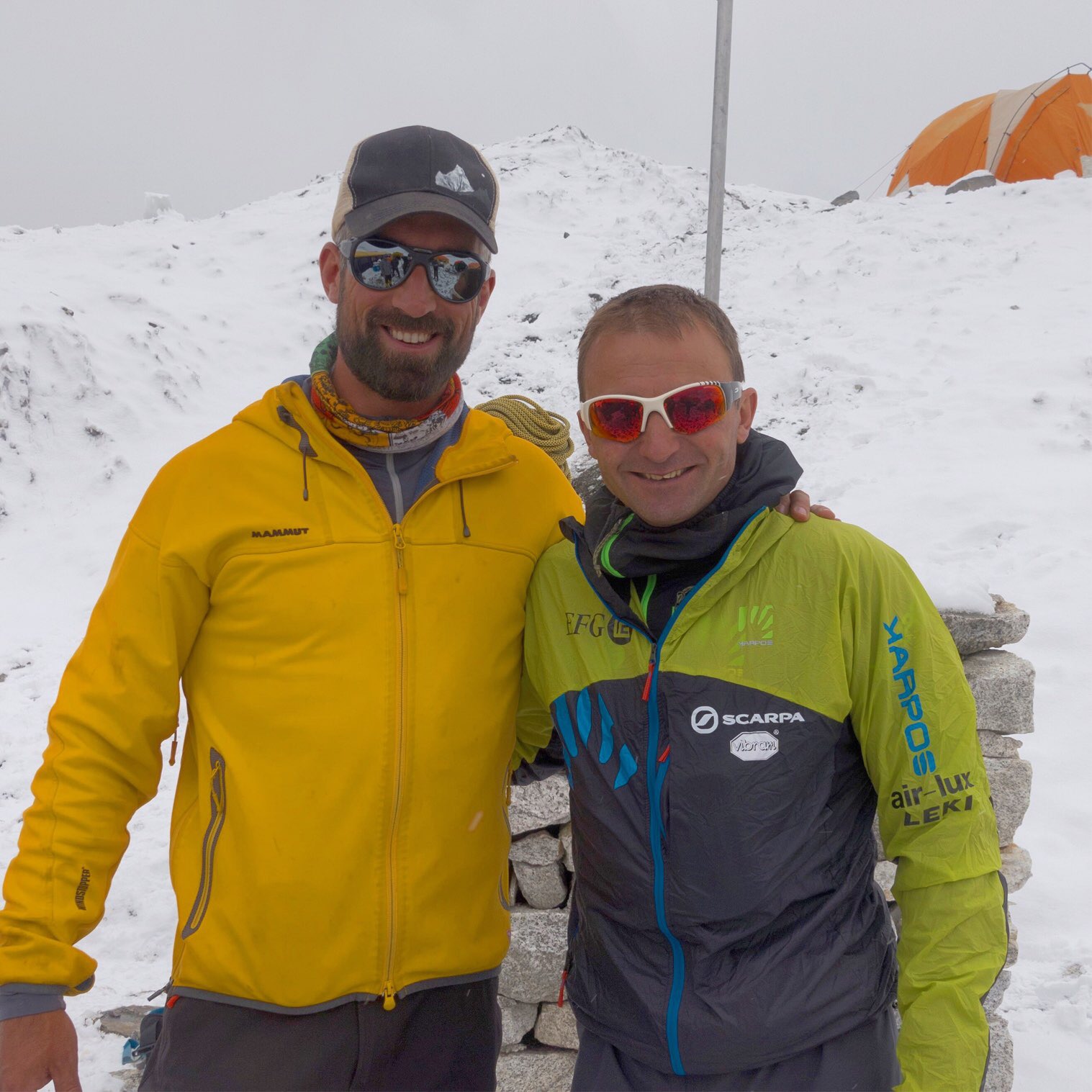EVEREST & LHOTSE
Practicing Patience at EBC
We have spent the last two days at EBC, while we rest up for our next summit push. At this point, it is a waiting game and I’m doing my best to practice patience. Below are my journal entries during this time…
Wednesday, May 10th (Rest Day at EBC)
Wow, what a bittersweet way to wake up. I slept like a rock and woke up feeling refreshed in the thick air (funny that 17,200 ft provides what I now consider to be thick air, even though it’s only about 55% of sea level) but I soon realized that it was the same day that I was supposed to be moving to C4. Despite my disappointment at not making our planned summit push, I felt more at peace with the fact that we had moved down. The frustration has morphed into acceptance and a new found excitement for our next opportunity to head up the mountain. However, I doubt I’ll be quite that enthusiastic the morning that we have to head back through that damn Icefall.
With the entire team back in camp, most of the discussion centered around the confusion that had occurred higher on the mountain. The rest of our team had received tidbits of information but were not privy to the actual drama that had occurred the previous day. At this point, I just explained the frustrating situation and had accepted the fact that I should be treating this as spilled milk.
If I needed to find an immediate silver lining, it was that our meals are much better than at C2 and I am not forced to stomach dal bhat with rock hard chunks of chicken. I should mention that our head cook has changed since our departure from EBC just a few days earlier. Our original beloved chef from England, Ant, had also come down with a viral infection, causing him to cough uncontrollably, and had broken two ribs in the process. He had been helicoptered to Kathmandu, diagnosed with broken ribs, and was now on his way home to England. Not only was this a disappointment because of his amazing meals but we will also miss his awesome personality.
Our team spent the majority of our day catching up in the dining tent, after being separated for so many days. The rest of the group was excited about the prospect of climbing with us for the summit push but I didn’t have the heart to tell them that we were still planning on departing early in an attempt to be one of the first teams to summit. Right now, it looks like we will make our next summit push on the morning of the 12th or the morning of the 13th, if we decide to skip a rest day at C2 to take advantage of more time at EBC. Of course, I will keep everyone posted as we hone in on a final decision.
Thursday, May 11th (Rest Day at EBC)
Today was supposed to be the day that we were going to attempt to summit Lhotse, if everything had worked out as planned, but instead we are at EBC, waiting patiently. I guess “patiently” would be a little generous because we are actually chomping at the bit to get moving again. Our days consist of sport eating, tinkering with gear, checking weather reports, and constantly asking when the lines will finally be fixed on the summit ridge. At this point, I have my gear for my next summit push lined up inside my tent and I could be ready to roll within half an hour.
So where do we stand at this point? The lines on the summit ridge have yet to be fixed and we do not yet have a definitive date as to when they will be completed. Weather is a bit of a moot point until the lines are fixed but it appears that there may be a window towards the middle of next week or early the following week. However, the weather reports that we have received are a bit contradictory, so we will need to give them a little more time to settle.
Sunset over the Madison Mountaineering Camp at EBC.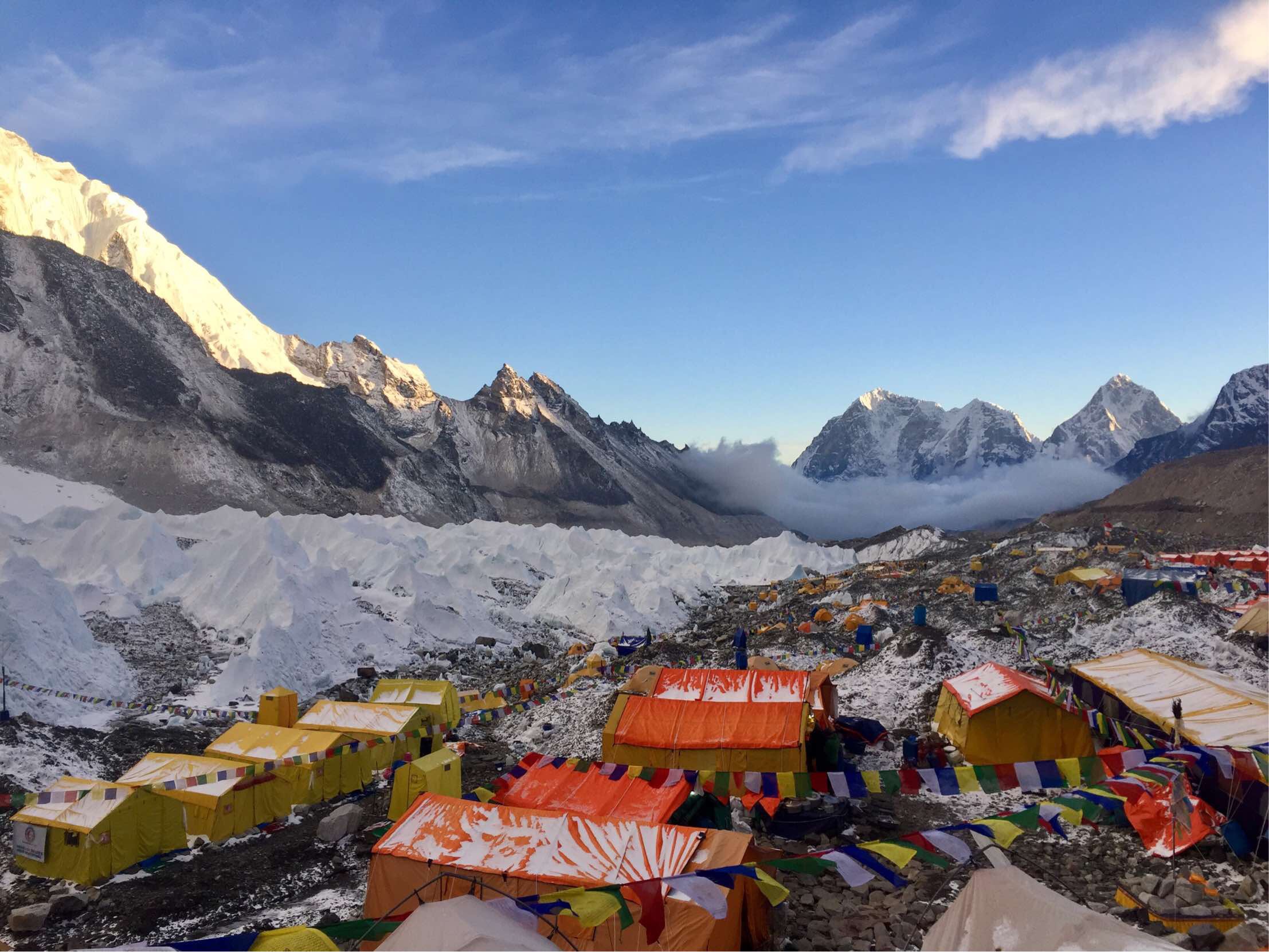
Last bit of sunlight on the peak of Nuptse. 
Other than scrutinize weather and obsess over gear organization, I spent the day drinking coffee, eating Peanut M&M’s, and napping in my snow covered tent. I know you are thinking how great that sounds but it’s about all that I can do right now. I’m doing my best to conserve energy and eat so that I don’t lose weight but it’s impossible because of the calories that my body is burning to distribute oxygen and remain warm. I’d guess that I’m down at least 15 lbs and our next summit push should cause that number to creep up. My big question upon my return is whether I should enter some trail races, to take advantage of my weight loss and hemoglobin count, or just focus on relaxing on the beach with chips and guacamole. I’m leaning heavily towards the latter…
I should have a better idea of our planned summit push in the next few days but in the meantime, keep those prayers and good vibes coming our way! Also, thank you for all of your messages, emails, notes, etc. I’m a little backed up on emails right now because of our spotty internet during the snow storms, so please don’t hold it against me if you haven’t heard back.
Q&A: Part II
Kathy:
- Will your team still be in the same queue as you originally were, once you can head out again? (i.e. willl you still be one of the first teams to head up the mountain?) Good question! The order at which teams summit is completely based on their ability to position themselves favorably for good weather windows. The summit ridge of Everest is extremely narrow and does not offer many opportunities to leap frog slower climbers. This is one of the primary reasons that the strongest teams on the mountain had moved up in anticipation of the lines being completed. We were looking forward to smooth sailing up the ridge, without being slowed by weaker/slower climbers, which could be the difference of 2-4 additional hours of climbing above C4. Now that about a week of time has been lost, it will result in a condensed timeline and a lot of jockeying for position between teams. This is one of the reasons that I was most frustrated with missing the awesome weather window opportunity. The short answer to your question is that it will be much more difficult to get our team on the front end of summit attempts but we will do everything in our power to do so, including moving up before completion of the lines to ensure that we are ready when they are ready.
Tanta Lisa:
- What exactly is an extreme temperature on Mt. Everest? Tough question. Ambient temps at basecamp are sub-freezing throughout the day and sub-zero above C2. Summit temps vary greatly but if I had to generalize, I’d say that they were usually between -25 and -50. While this sounds awful, you have to remember that the sun creates a great deal of solar heat, which results in what feels like much warmer conditions than the ambient temps might suggest. What makes a temperature extreme is the windchill and overcast skies. A summit day with temps at -25 is great but throw in overcast skies and 30+ mph winds and you are in extreme/dangerous territory. That is why the primary variable that we watch for summit windows is wind speed, not ambient temps.
- How many pairs of socks do you wear at one time? When climbing, I wear a pair of liner socks to prevent blisters and a pair of mid-heavy weight knee high climbing socks. I can usually get about 5-7 days of climbing out of them before they are unbearable.
- Have you learned to like eggs? I’ve liked eggs for a long time and look forward to them every time I get them up here. I still have no idea how they get them up here without breaking 90% of them. The porters and sherpas will literally carry them on their back for miles.
- To Geoff: What is John’s more endearing trait? Geoff is planning on writing a post soon, so I will let him answer this when he does to avoid anyone accusing me of giving myself a compliment.
Anonymous:
- Do the Sherpa’s have a union? I feel like a formal complaint should be lodged. Agreed but unfortunately the setup is based on a few Westerners at EBC organizing a group of Sherpas that come from a number of teams. Teams that do not have Sherpa representatives will pay their portion for the gear and labor. It usually works but when it doesn’t it becomes quite the cluster… see 2017.
Pol:
- In the summit push will you use a flow rate of 4lpm? I think that two canisters is not very much, and more oxygen is very beneficial. We will most likely not use a flow rate of 4lpm, unless the route is clear and we are able to move quickly. When we were planning on being one of the first teams to summit, we were planning on running at 3lpm and bumping up to 4lpm if we could move quickly. I guess this is a good opportunity to give a lesson on supplemental oxygen usage… Oxygen flow rate is measured in “Liters per Minute” (lpm) and can be adjusted in increments of 0.5 lpm. When at rest at high altitude, a person using supplemental oxygen will normally run it at 0.5-1.5 lpm. When active that range can increase up to 4 lpm with some regulators allowing up to 6 lpm. So why not just run at max flow while you climb? Well, each canister weighs about 8 lbs and when oxygen is released, some of it is pushed out of the mask when you exhale. The goal is to have a balance between speed, weight, and time climbing. If you are slowed by climbers in front of you, you will most likely drop your lpm’s to conserve O2 because you will not be moving as fast. If you are moving quickly, you will most likely increase flow because you will expend more energy. Now that I’ve provided the lesson, we will each carry three canisters and will adjust flow based on the speed at which we ascend. If we have a clear path, we will probably use a flow rate of 3 lpm, which will allow for two canisters to last 8 or so hours.
- What are you using to have Internet? Thuraya IP+? Do you have unlimited Internet? Our satellite phones are Thuraya’s and we do have a Thuraya IP+ for internet, although it is only used by our leads for outside communication, due to limited bandwidth. There is a service called Everest Link, which is available throughout EBC, and is used by most climbers. It definitely isn’t free or unlimited, with a cost of $50 for 1 GB or $225 for 7 GB. I’m about $900 in the hole so far.
- I also have readed that there is controversy about Hypoxico tents to acclimatize at home. What do you think about altitude tents? Personally, I have never tried one and I have heard mixed reviews on their success. We have four team members that have used them; one of which already went home with HAPE, two others that seem to be having normal altitude issues, and a fourth that used it supplementally and hiked in on the normal routine. It is a fact that they will increase your hemoglobin count but without a pressurized chamber, it is impossible to simulate the lower barometric pressure that is present at altitude. While people continue to find some success using them, most experts agree that they aren’t a sufficient alternative to the normal acclimatization process. Personally, they scare me and I don’t plan on ever using one, especially after seeing the challenges that some of the users have faced.
- And the final question is about medicine. What medicine do you bring and what medicine have you taken so far. What do you use or prefer to treat the khumbu cough? We have a lot of medicine up here, some for altitude and some to supplement our weekend immune systems. We also takes lots of vitamins and some supplements because our bodies are constantly under stress and nutrition can be lacking up here. As for altitude needs, there are three primary meds that we carry: Diamox for Acute Mountain Sickness (AMS), Dexamethazone for High Altitude Cerebral Edema (HACE), and Sildenafil (Viagra) for High Altitude Pulmonary Edema (HAPE). Diamox can be taken proactively or to treat AMS, while the other two are only used in case of emergency. I will sometimes take a small (125 mg) dose of Diamox when moving to a higher altitude because it helps me sleep better. In regards to the Khumbu cough, it’s a real thing, primarily caused by the dry and cold air. My nasal infection caused me to breathe through my mouth and resulted in me picking up the Khumbu cough. Some people also get it from sucking in dust on the trek in. Unfortunately, it’s not bacterial or viral so you have to get used to it until you descend. The only thing that you can do is take throat lozenges, mucinex or other cough suppressants to ease the symptoms.
Jason:
- What does Everest sound and smell like? What are some sounds amd smells you will remember? I guess the best way to answer your question is to separate into the sounds and smells of nature vs the human element. The three sounds from nature that I constantly hear are wind, snow and avalanches. In the Western Cwm you can hear the wind coming down the valley and it quite literally sounds like a freight train, even before it hits anything. Snow is constantly peppering our tents or our jackets and has come to be very soothing. Avalanches are unpredictable but we hear one about ever 1 to 2 hours, each varying in sound and duration. Some of them sound like a bomb, while others sound like a train derailment, neither of which is very soothing. As for smells, it’s a relatively sterile natural environment, so the only smells that are present are caused by humans. The most recognizable of which is the smell of burning kerosene, which the Nepali people prefer to burn at C2. It’s pungent smell gets on everything and even the boiled water takes on it’s odor. At EBC, there are all kinds of noises and smells, it is like an international market but with sounds and smells drowned out by the vastness its footprint. You only have to walk a hundred yards to hear a new language, smell a new cuisine, or hear music that you have never heard before.
- What piece of gear are you grateful/surprised how useful it has been? What gear should you have left home? Most of the actual gear that we use is necessary at some point or another so it is difficult for me to put my finger on anything that has exceeded or fallen below expectations. I would have to say that the most valuable item that I brought was my mini all-terrain stereo because we have it running about 90% of the time that we are climbing and then most of the time at EBC. We take turns DJ’ing and it definitely helps to keep morale up. As for least useful, I’d have to say it’s the pile of alkaline batteries that I brought. For whatever reason, it completely slipped my mind that Alkaline AAA batteries are more or less worthless in this environment. Luckily, I brought a handful of Lithium AAA’s that have to do all of the work. Let’s just hope that those four workhorse Lithium batteries in my headlamp don’t go out on one of the nights that we are pushing for a summit or I’m going to be in trouble.
Heidi:
- Is it true that there is human waste all over the mountain? Despite what you might have heard, I was surprised by the cleanliness of the mountain when I arrived. There has been a number of publications that have critiqued the Nepali government for not better regulating garbage and human waste on the mountain. It’s definitely no Denali but the government and climbers have done a good job of cleaning up over the years and now the only waste that you see is usually from the current year. The reason that human waste can be such an issue is because we are in a sterile environment. Without insects and bacteria, there is nothing to break it down and it remains frozen in the ice for years. Luckily, the only human traces that I’ve identified is vomit in the Icefall, from people who are having altitude issues, and the occasional emergency defecation.
Journal from 1st Summit Rotation
While everyone already knows the outcome of our first attempt at a summit bid, I wanted to share my journal entries leading up to yesterday’s return to EBC. Despite the eventual disappointment, we did have some fun along the way, which you will soon see 😉
Saturday, May 6th (Depart for Summit Rotation)
Today we woke up at 3:45 and quickly got dressed in our tents. I made it to breakfast at 4:07, only seven minutes later than our target. I figured that I got about 3:45-4 hours of sleep, after answering as many emails before my data card ran out. It was probably a good thing because I doubt that I would have shut off my iPad before it was time to go. I hope that everyone that didn’t get a response will understand why I didn’t get back to them before Summit Rotation. I promise I did my best!
Alright, so where did I leave off before my email tangent… Oh yes, breakfast. The four of us met in the dining tent and had what has become our customary porridge and coffee, four parts coffee and one part porridge. We each did our own bit of complaining about the time of departure, which is actually ridiculous because the other two groups in our team usually depart between 1 and 2 AM. We have justified our late departures by stating the importance of morale on a day of climbing, tired and grumpy climbers do not make for a cohesive group. The other interesting piece of information that reinforced our late departures is the observation that all of the major collapses in the Khumbu Icefall have occurred between 12 and 4 AM. Now that I have justified it to you, I can move on with the story of our day.
We had one last task before breaking camp for our Summit Rotation, we had to pay our respects to the Pujah (the altar that had been built in the middle of our camp prior to the beginning of our expedition). The four of us circled it three times, always clockwise, and on the third rotation, we bent to inhale the smoke from the fire. We then picked up an offering of rice, which we gently tossed onto the Pujah three times. Thus, we had made our offerings and paid our respects to the Pujah and our Summit Rotation could commence. We gave hugs to Andrew and Bolah, our EBC managers, and were on our way.
The climb through the Icefall was more or less uneventful because there were hardly any climber en route, in either direction. Our belief is that most climbers were resting at EBC and wouldn’t start their Summit Rotation for at least another week. I struggled through the first few hours of climbing because my throat has yet to improve. Due to the pain caused by the cold air on my throat, I have to wear a buff most of the time but struggled to get the oxygen that I need because of air flow restrictions through the buff. To make matters worse, when I’m expending a lot of energy and breathing through my mouth, the buff quickly collects moisture and does not pass air as easily. I’ve compared it to a sprained ankle, an ailment that slows you down a bit but is more painful than anything. I’ve accepted the fact that I’m probably stuck with it throughout Summit Rotation and I am just going to have to suffer through it.
The “new” tallest ladder in the icefall, comprised of four ladders stitched together with rope. It’s “new” because it used to be three but was extended to four when the ice below settled. (Photo by Geoff)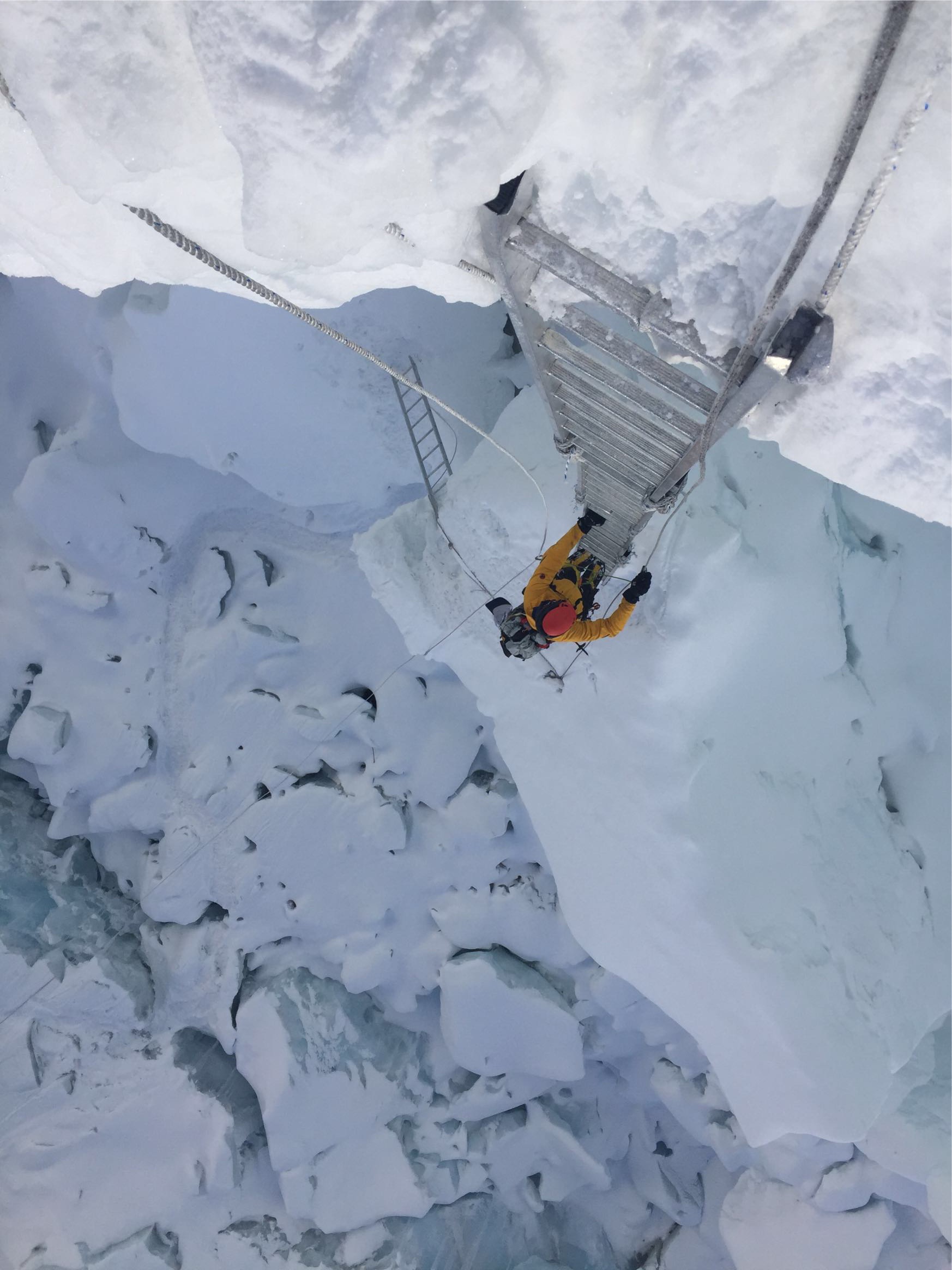
While I mentioned that the climb through the Icefall was mostly uneventful, that doesn’t mean that it wasn’t interesting. Since the first time that we passed through the icefall, the terrain had changed significantly. The Khumbu Icefall is basically a living thing, changing day-to-day and moving as it pleases. Up to this point, there had been numerous serac collapses in the Icefall since we arrived but only two of which affected the route that climbers took through it. We arrived just hours after the third, a large collapse that had covered the line and we had to do our best to improvise, weaving our way through and over giant chunks of ice. We made it through without any issue but we made note of two additional areas that we all agreed would probably collapse by the time that we make it back through on our descent. I’m very grateful that we have completed 5 out of 6 passes through the Icefall, with our descent off the mountain as the final pass.
Brent looking down on C1 (Photo by Anders)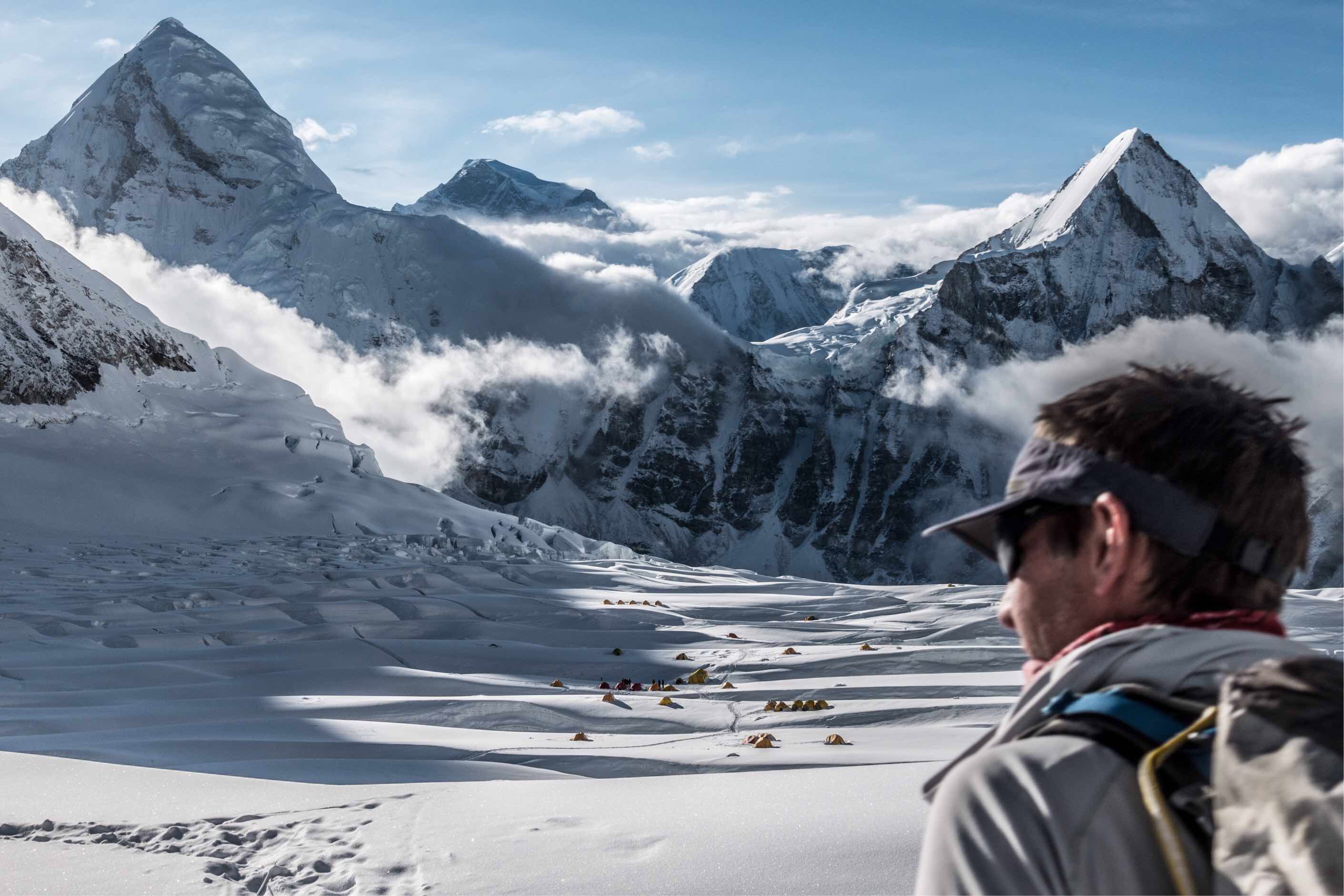
Our team moved quickly and we made it to our Camp 1 location, where we spent two nights on the 1st Rotation, in 4:45. We took some time to relax and the moseyed on to Camp 2. When we reached the final horizontal ladder, one that spanned a 200+ ft deep crevasse, Brent said, “I guess it’s time for pull-ups”. This was in reference to a bet that we had made on our first day of our trek to EBC. We had been crossing one of the large bridges over the ravine and I asked him if he dared me to do pull-ups off it of, to which he said he wanted me to do them off one of the crevasse bridges. Now that you know the origin of the comment, I bet you can guess what ensued… Geoff kicked it off by lowering himself off the middle of the ladder and doing 3 pull-ups, followed by some fancy acrobatics that put me to shame. I bested him with 5 pull-ups but far less flare. There is potential for these pull-ups to be the highest elevation pull-ups on a ladder ever… just saying. (Mom, you might want to skip this part and I apologize for the profanity in the videos)
I may have won the pull-up competition over the 200 ft deep crevasse…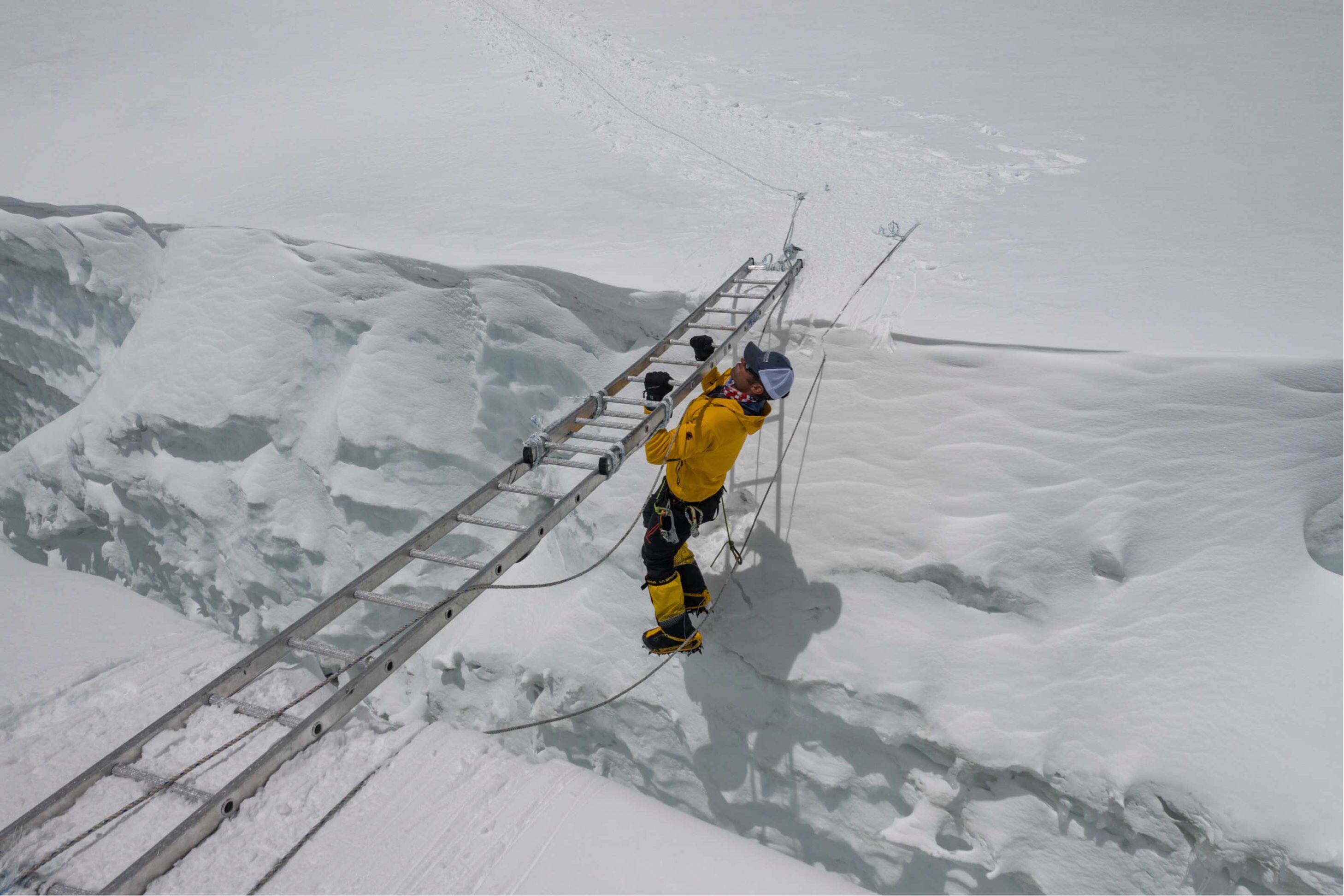
But Geoff won in style points with ease. 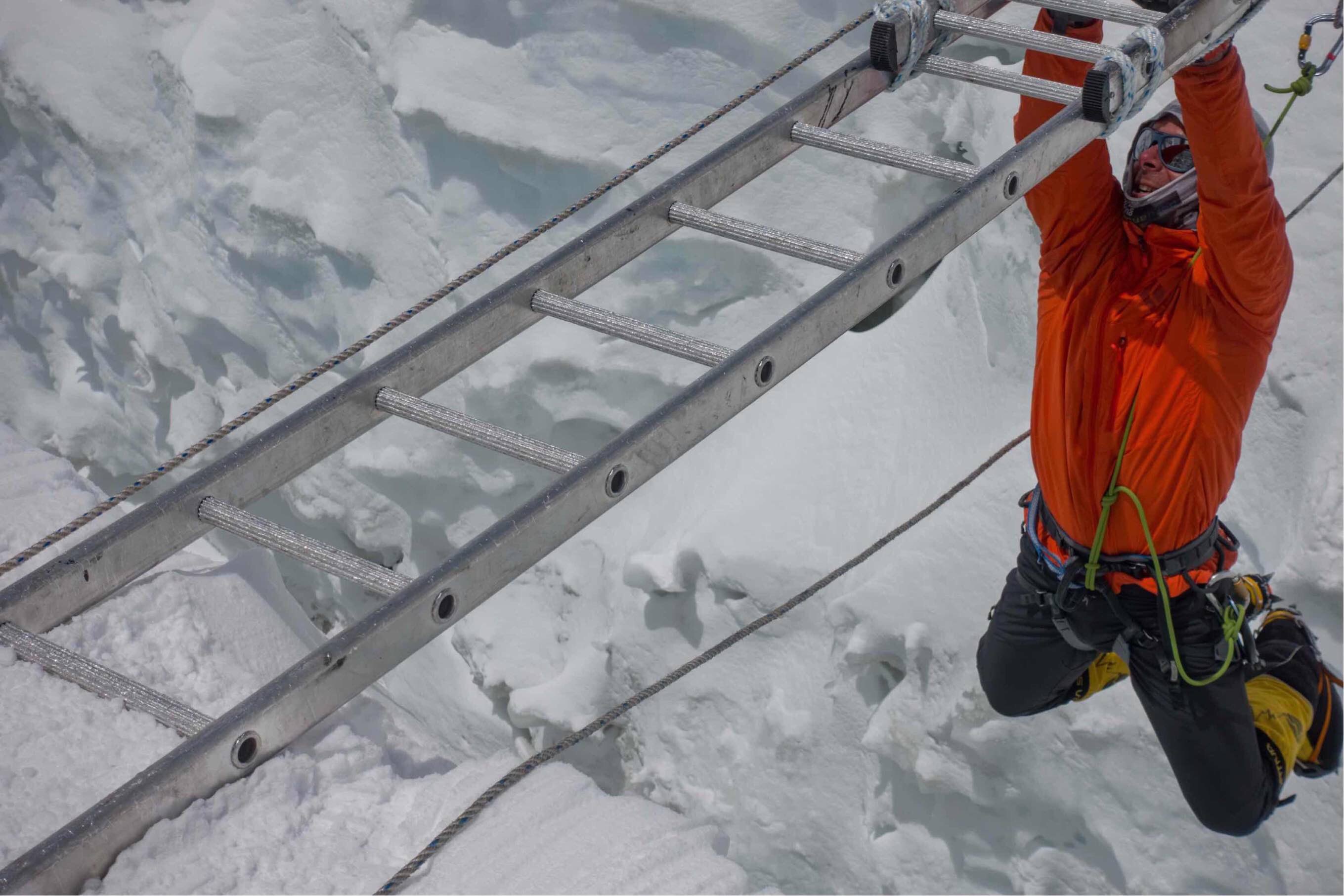

We reached C2 a few hours later and quickly unloaded our gear, before we had soup and tea. After binging on liquids, we crawled into our tents and took naps. Before we knew it, it was time for dinner, which was very subdued since we were groggy from our 8:45 of activity and 3,800 vertical feet of gain. Time to sleep like a rock…
Sunday, May 7th (Rest Day at C2)
Today was somewhat of a strange day, I really struggled with a lot of frustration and anxiety. As I expected, I slept like a rock but all of the effort that I had expended the previous day caught up with me and did it’s damage on my throat. I woke up with the worst throat pains that I have had in a week. Outside of the nasal congestion and the throat pain, my body feels great but it’s taking a mental toll on me. I’m doing everything that I can to take care of it but it just isn’t getting better and my patience is running thin, not that I had much to begin with.
Every morning when we sit down for breakfast, I feel like we have to run inventory on health. The two questions that you know you are going to have to answer are “How did you sleep?” and “How do you feel?”. Well, as you might guess, I’ve become extremely tired of answering the latter. I’m fairly certain that this is the seventh day that I’ve had this virus and the second entire rotation that it’s been present during. Generally, I try to suck it up and hide my frustration but I wasn’t having it this morning, my throat was hurting more than normal and I could barely speak. When it came my turn to answer, I was honest and said “I slept well and my body feels great but my throat is killing me and I am really frustrated with it.” The guys know where my head is at and they didn’t prod anymore, they are just concerned. I’m just lucky that this has been isolated to my throat and hasn’t spread to my lungs. As long as it remains this way, I will be able to manage through the pain and it shouldn’t affect my performance.
One of our many conversations in the dining tent at C2. The topic is most likely not serious, judging by Geoff’s expression. (Photo by Anders)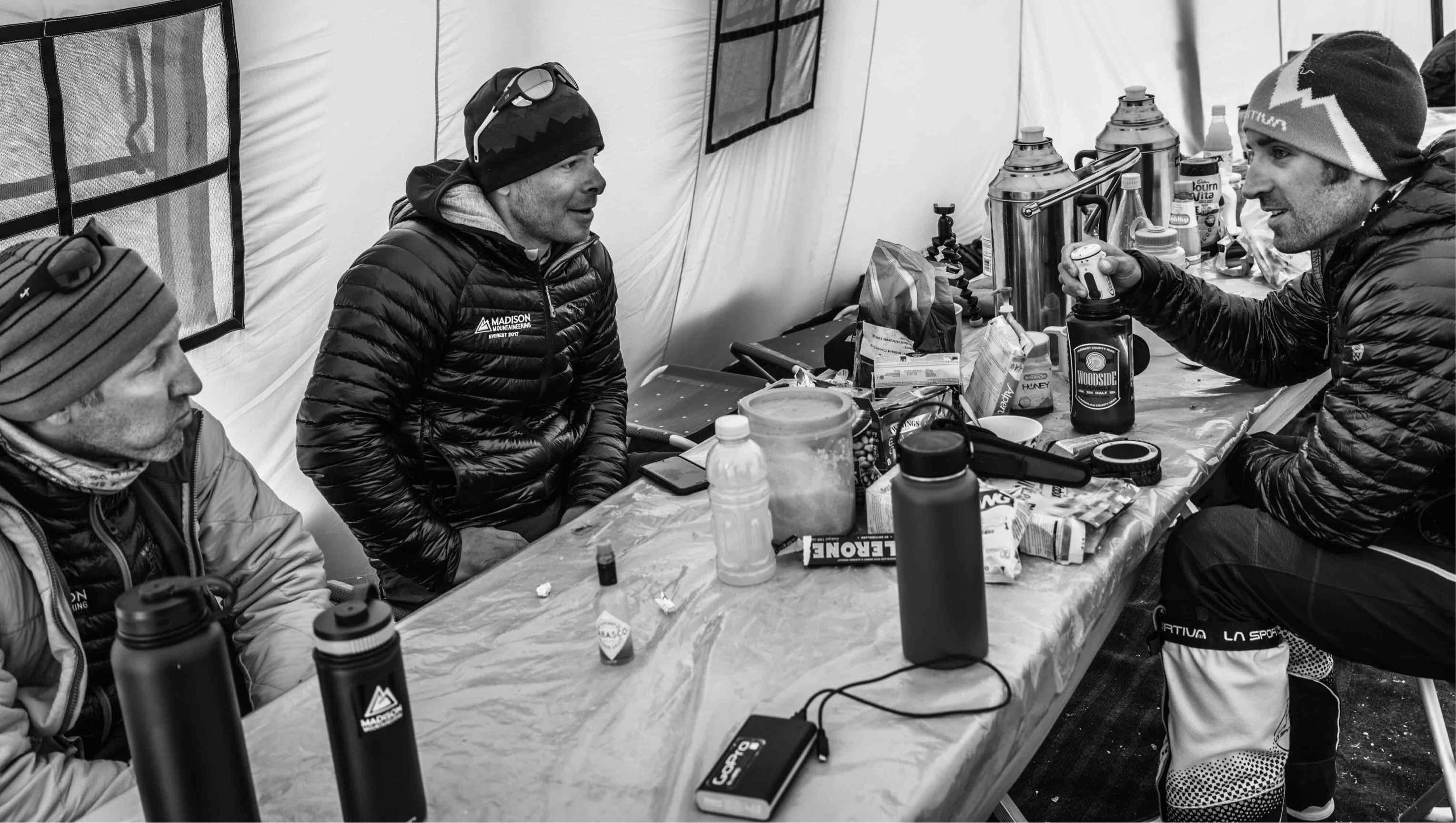
Later that afternoon, we sat down as a team to discuss our plan. The initial plan called for us to move up to C3 tomorrow but with the delays on the line fixing, we decided that it was best to take another rest day at C2 and make our move on the 9th. No one was disappointed because it was something that we had anticipated and another day of rest is always a good thing. We spent the rest of the day lounging and napping, one of my favorite activities at altitude.
Monday, May 8th (Rest Day at Camp 2)
Another night and another morning with a soar throat. It was a bit better than the previous mornings but it remains an annoyance. The fact remains that it is nearly impossible for the body to recover from sickness or injury at 21,000 ft. The lack of oxygen forces the body to prioritize and it generally focuses on basic bodily functions and movement. I have cuts and scrapes that are over a week old and would have been gone within days, had I been at sea level. Oh well, if a soar throat and some scrapes are the only thing that I have to deal with, I’ll be fine.
Snowy morning at C2. (Photo by Anders)
We had a few visitors throughout the day, mainly members of other teams who are on the fast track to summit early. A couple of the leaders from one of the British Expeditions stopped by for tea and we had some good laughs. Their plan is to move up to C3 tomorrow morning with a goal of summiting on the 11th, the same as us. We had all heard that the line fixing was being executed as scheduled and that the Sherpa team had reach the balcony, leaving them about 60% more to finish the following day. This shouldn’t be an issue based on the favorable weather forecast for the upcoming days. My best guess was that there were 5-10 teams that had mobilized at C2 for an early summit, which would put our foursome at the very front end of summits for 2017.
After lunch, Geoff and I went to the tent to organize food for the next four days. We filled two Ziplocs for two days moving between camps, C2 to C3 and C3 to C4. This food is almost entirely carbohydrates and consists of trail mix, cookies, candy bars and other simple sugars. We also each filled two smaller bags for our summit attempts, Everest and Lhotse, which consisted of all simple carbohydrates that were easy to consume, such as Gu packets, shot blocks, and candy bars. When it comes to summit food, flavor doesn’t really matter but you need to make sure that the food is easy to consume, won’t freeze and will provide instant energy.
Dinner was next and we had dal bhat… again. I am sooooooo tired of dal bhat but it is one of the few things that can been cooked sufficiently at 21,000 ft. I forced it down because I need the calories. Luckily for me, I haven’t lost my appetite, which is a sign of deteriorating health at altitude. Despite my appetite, I am really starting to shed the weight. My estimate is that I’ve lost about 15 lbs already because my pants and harness are already starting to slip off of me. I hope we get up this mountain soon because I really want to avoid losing more than 20% of my body weight.
Alright, I need to get some good sleep tonight because I won’t have that luxury for the next few days.
Bonus night photo of yesterdays decent to EBC. Anders caught this photo of Brent about to rappel, right after I got off the rope, with Geoff in the foreground.
Hitting the Reset Button
I know that everyone was anticipating a call from C3 today with an update on the move to C4. Unfortunately, that is not the case, as those of you who have been monitoring my GPS tracker have noticed. I appreciate all of those who have already reached out to check on my teams health and to make sure that everything is OK. While we encountered some obstacles today, I can assure you that everyone is safe and healthy, albeit a little grumpy. Before I elaborate, we are in fact back at EBC and we will be heading back up in a few days.
I woke up at 6:33 AM this morning and was wide awake. I had an overwhelming feeling of anxiety and could not go back to sleep if my life depended on it. Now this anxiety wasn’t the type of nervousness that you might get before a big presentation but rather, a feeling of being overwhelmed by the workload that lies before you. I knew that starting today around 1 PM that I would have to climb 10,500 vertical feet over a three day period, all above 20,000 ft in elevation. Strangely enough, I wasn’t scared just a little overwhelmed by the workload and the minimal sleep that I would have over the next few days. I laid there for about two hours, as each possible scenario ran through my mind and I found solutions for every possible challenge that I would encounter. After those two hours, I suddenly felt calm, as I felt confident in the daunting task that lay ahead of me.
It was no more than five minutes later that I heard Phurba Sherpa (our head “sirdar” Sherpa) walk over to the tents to say good morning. He then said, “I have some bad news”. He explained that the Sherpa teams that were high on the mountain had pulled back due to extremely cold temps and white out snow conditions. This is the team that is responsible for fixing new lines (ropes) on the steep sections of the climb. These lines were supposed to have been completed by today or tomorrow, which is why we and several other teams had moved into position for early summit bids. The weather forecast for the 11th through the 13th is fantastic for climbing and offered a safe opportunity for those teams that were prepared to move early, including ours. This initial news was bad but we needed more before we could make any decisions.
Brent, Geoff, Anders and I met in the dining tent to discuss. As we did, one of the British teams moved passed, led by one of Brent’s old friends, Kenton. Brent went out to talk to him because he is one of the guys that always knows what is going on. When Brent returned, he had a half smirk and half look of disappointment on his face. He said “Well the outlook isn’t good but it is almost worth it because Kenton almost fell over because he was so mad”. Kenton’s team had moved to C3 the day before and was attempting to be the first team to summit but were now moving down to EBC to rest because the outlook was so bleak. That was about the point when we all started to see the writing on the wall. We watched as team after team packed up and headed down valley to EBC.
We spent the next few hours on the radio with our team at EBC, trying to figure out what had happened and if there were any other options. The clearest story that we have is that the Sherpas that were responsible for fixing the line, had grown tired from fighting the poor weather and called off all efforts until further notice. They had descended from C4 to C2 and then returned all the way to EBC for rest that morning. Just to give some background, the team of Sherpas that are responsible for fixing the lines on Everest and Lhotse is comprised of Sherpas from various teams on the mountain. No single person controls the team but there are generally a couple people directing the group. Unfortunately, this year, a few teams pulled there Sherpas back early and then the poor weather his, so things quickly fell apart.
After receiving the initial news for Phurba, around 8:30 AM, we waited several hours. We made calls to try to rally a new group of Sherpas that would be able to get back up the mountain in the next couple of days but had no luck. I even lobbied to climb without the fixed lines, a plea that was met with a lot of eye rolling. Geoff and Brent know damn well that we are capable but it is much riskier and would be frowned upon by the others on the mountain. This left us with very few options, either we rallied enough Sherpas to get things moving in the next couple days or we would need to head back to EBC, where our bodies are able to rest and recover.
Around 3 PM, Phurba walked over and informed us that the earliest that the lines would be fixed would be the 15th. We knew what that meant, we were going down. C2 is at 21,000 ft and our bodies really struggle to remain healthy at that altitude, so with our climb delayed several days, we had no choice. We were all upset, angry, frustrated, etc because of the work that we had put in and knowing that we had done everything right on our end. This effort and great weather window fell victim to poor leadership, a lack of organization and zero accountability by all parties involved. Our team had had the opportunity to be one of the first few teams to summit this season but instead, we were heading back to EBC to lick our wounds.
Our team begins the descent to EBC.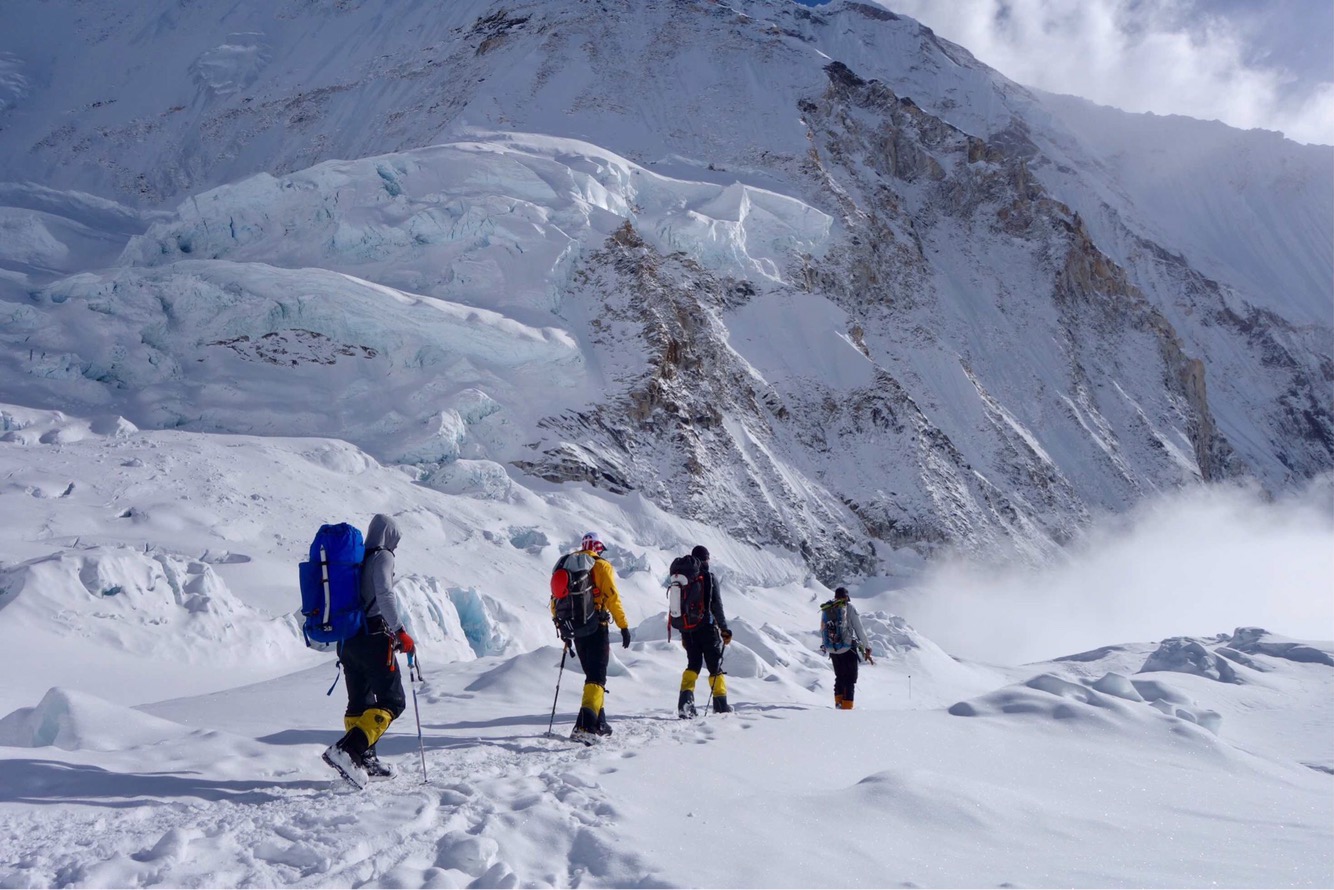
I’d like to tell you that we got over it and enjoyed our climb but we didn’t, except for Geoff. He is so damn optimistic all of the time and never misses an opportunity to check to see how everyone is doing or crack a joke to try to get a smile out of you (Beth, you did a good job). Unfortunately for him, it was tough to crack the frustration. Personally, I was ecstatic to only have one more descent through the Icefall but now we have to do an entirely new lap through it, our fourth. If I haven’t made it clear, it’s not fun going through that maze of death. Out of our six trips through it, four have been over new routes because of collapses on the original routes. Despite my dramatic description, we made it from C2 to EBC in a blazing time of 3:45 and only spent the last 1:30 in the dark.
View of C1 and Pumori just before sunset on our descent. 
It felt good to be back at EBC but it remains a very challenging day. I can’t begin to describe the roller coaster of emotions that I experienced today, from psyching myself up for the climb of a lifetime to realizing that I had to go back to the starting line. I know that it will work out, all it’s going to take is a little more time and effort, but that doesn’t soothe the sting of today. That will fade over the next couple of days and once I make it back through the Icefall and set my eyes on that mountain, I’m sure it will be business as usual. I just find it so strange that it is so easy for me to get caught up in the day-to-day here, when in the grand scheme of things, the cost of a few more days is minuscule. Luckily, I can rely on all of you to keep my head screwed on straight. With that, I’m heading to bed to rest up for my 4th Rotation in a few days…
Call from Camp 2, Headed to Summit
Summit Dreams
You know when you mark your calendar for a big occasion? You spend countless hours/days preparing for it… You can’t sleep because you are always thinking about it… You borderline obsess over the details… but it still seems like that day will never come.
Then all of a sudden, it’s here and I’m looking for some figurative brakes to pump.
Anyone that knows me would be certain that I have had this message planned for weeks and know exactly what I want to say. Well, I don’t. I know that my body and mind are ready for this final summit push but finding the words to describe how I’m feeling is slightly more challenging.
Everest (left) the tallest mountain in the world, Lhotse (center) the fourth tallest, and Nuptse. 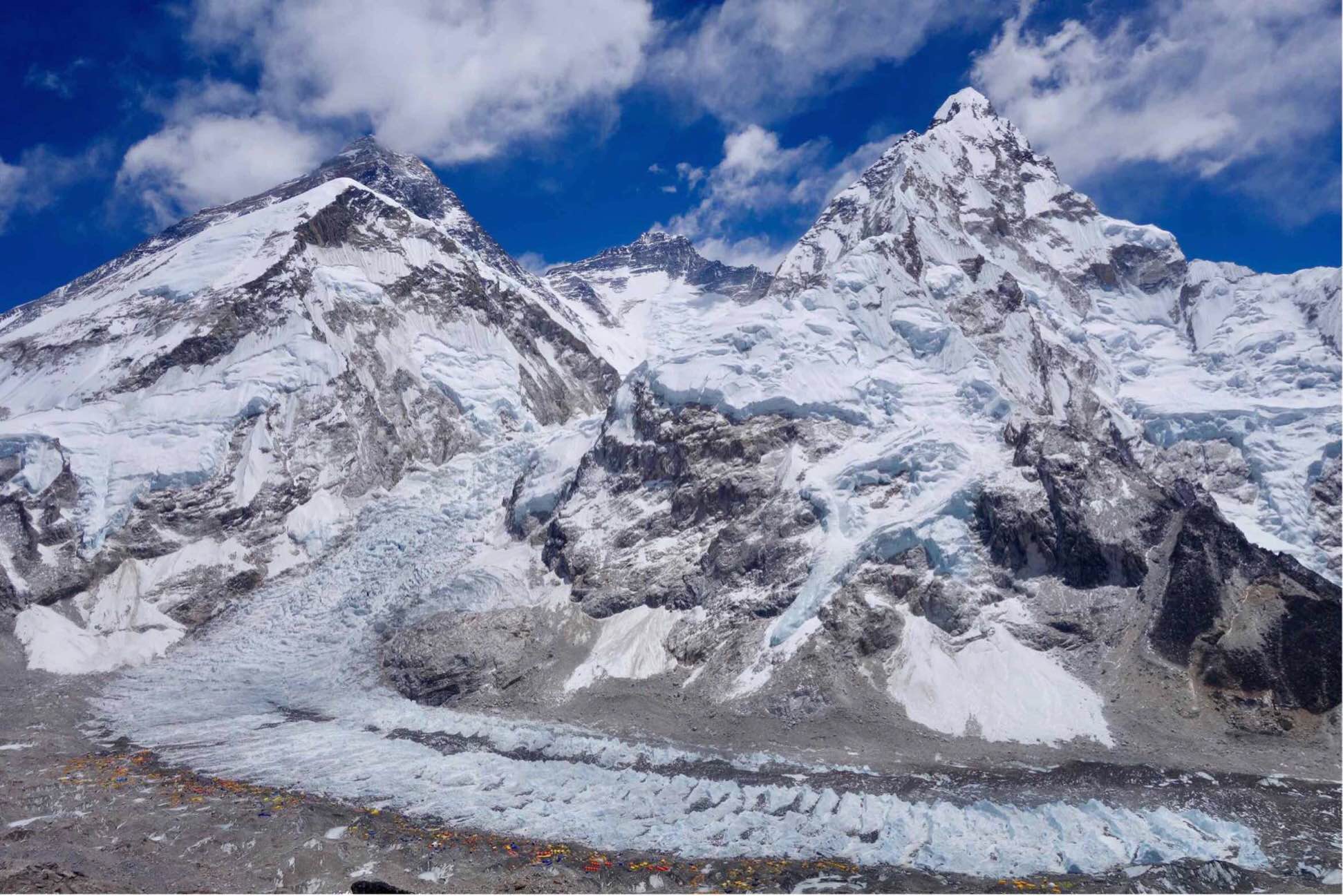
I need a little more time to find the right words, so I’m going start with the plan for our summit push. Tomorrow morning, Anders, Brent, Geoff and I will break camp at 5 AM to begin our final/Summit Rotation, which will involve us moving through the camps to get in position to take advantage of a fair “weather window” that would allow us to summit. Over the past few days, we have been reviewing the weather forecasts that we receive and they continue to point towards wind speeds decreasing over the next five days. Right now, the dates of the 10th and 11th are showing the best conditions with temps ranging from -15 to -40 on the summit with wind gusts reaching 25 MPH. Yes, I know that sounds like hell but trust me, that actually sounds pretty good, it can be much worse.
We use the forecast to make our best guess at when the weather will allow us to move, so that we are in striking distance when that “weather window” opens up. Here is our planned schedule for movement but please remember that schedules are very prone to change in the mountains. Don’t be alarmed if we have to push our plans back one, two, or three days.
- May 6th: Depart EBC @ 5 AM and climb to C2
- May 7th: Rest Day at C2
- May 8th: Move to C3 in the AM
- May 9th: Move to C4 in the very early AM, nap, depart for summit around 11 PM
- May 10th: Everest Summit target of 6-8 AM, descend to C4 by Noon, nap, depart for Lhotse summit around 10-11 PM
- May 11th: Lhotse Summit target of 6-8 AM, descend directly to C2 by midday
- May 12th: Descend from C2 to EBC
- *Nepali time is 9:45 ahead of EST and 12:45 ahead of PST
Please remember that all dates and times may change depending on weather and health. I want to avoid panic, in the event that something doesn’t happen as scheduled. Additionally, we may not attempt Lhotse if conditions are not ideal. In which case, we would return to EBC on the 11th. Lastly, I will not have any cell or internet service up there but will have access to a satellite phone. I am going to do my best to call in twice a day with updates but don’t hold it against me if I miss a call or two because of too much cloud cover or sheer exhaustion.
Now that you know the plan, I guess I can’t stall any longer, it’s time for me to get a little sappy… I have been working towards this for a very long time and while it’s only been on my calendar for about a year, I have had dreams about the summit of Everest for years. It was the product of years of inspiration from so many people in my life, I would never consider this a dream that I conceived on my own.
I don’t know if I will reach the summit but even if I don’t, this journey was well worth the blood, sweat and tears. I can’t begin to explain the impact that this mountain and climbing have had on me and my life, not just over the past month but over the years. This journey has helped me find some of my closest friends, better understand myself, rebuild my relationship with my father, and now, share in the inspiration. I promise you, even if I don’t make it to the top, I wouldn’t change a thing.
Now, it’s time for me to thank you. If it were possible for a group of people to will a body to the top of Mount Everest through love, encouragement, support, well wishes, inspiration and plain old good vibes, I would be on top right now. Over the past month, I have been completely overwhelmed by the messages that I have received. Isn’t it ironic that whenever I receive a message about me being an inspiration to that person, that they are in turn inspiring me?? I’ve had some rough days on this mountain, feeling sick or even being homesick… but then I read your messages and I smile. To each and every one of you who are reading this, thank you from the bottom of my heart.
My team; Anders, Me, Geoff, and Brent. 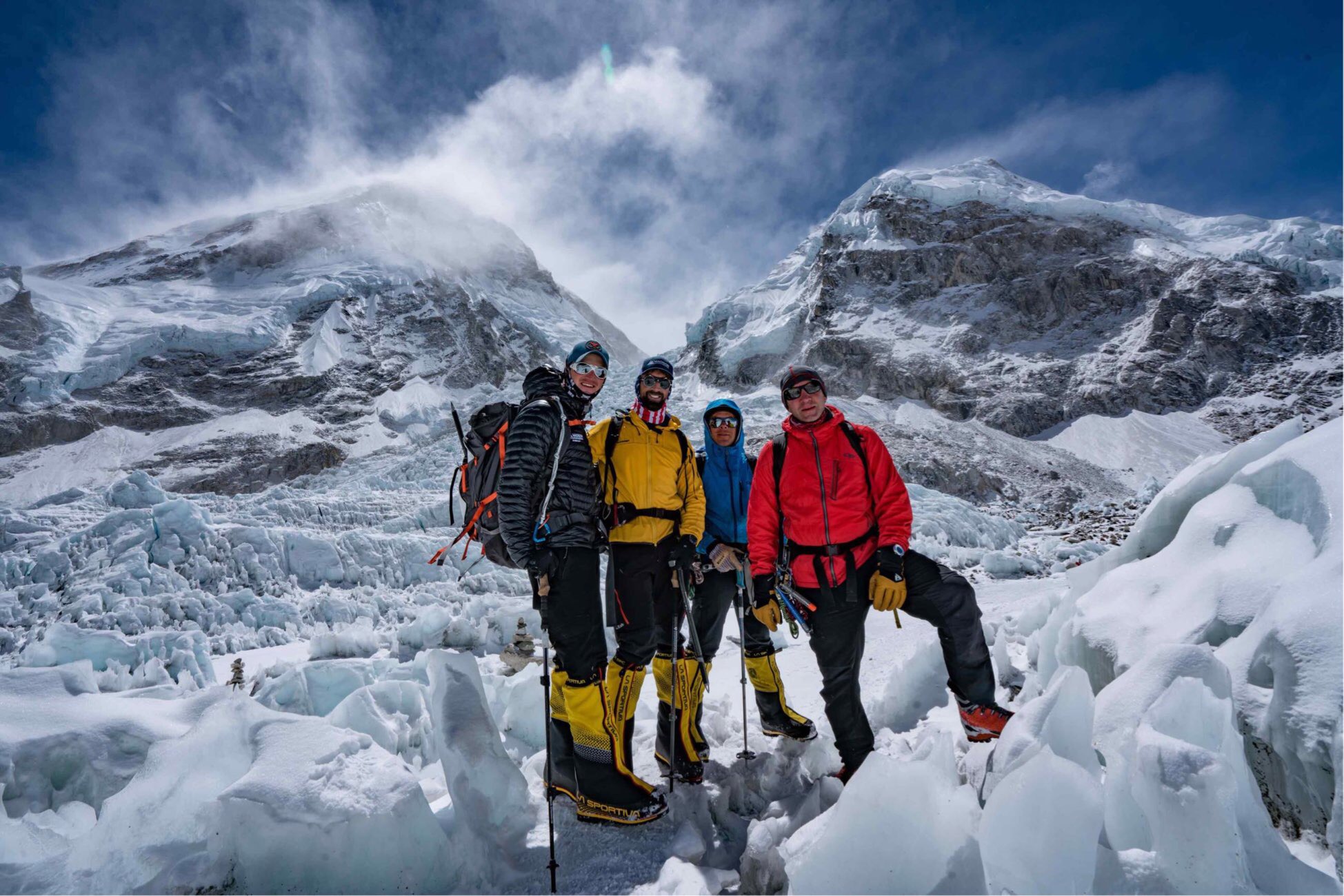
Finally, I believe that I am a member of the strongest team on the mountain. I trust Geoff, Anders, and Brent to pick me up if I fall down and they know that I will do the same. There is no doubt that this climb will be incredibly dangerous but rest assured that we will take care of one another.
My promise to you… I will give this my all.
Namaste,
John
Lhotse: The World’s 4th Tallest
WARNING: Family members may want to sit down before they begin reading this post…
With our summit push departure set for tomorrow morning, there is something that I need to get off of my chest. I have secured a permit to climb Lhotse and plan to attempt to do so shortly after Everest, weather and health permitting. Lhotse is the fourth tallest mountain in the world and the sister peak to Mount Everest. Less than 700 people have ever summited Lhotse and only 20 individuals have summited both Everest and Lhotse in a 24 hour period. Everest remains my #1 goal but if my body is able, I want to give it my all.
Mom and Dad, I promise to be responsible in my decision to push for a summit of Lhotse and will pull the plug if the weather or my body are not cooperating. Geoff, Anders, Brent and I all secured permits, so we are in this together. We have a strong team but more importantly, we trust one another. Please know that we will be honest with each other. I truly believe that this is one of, if not the strongest teams on the mountain.
The tentative plan will be for us to summit Everest on the morning of the 10th, return to C4 on the South Col (the bridge between Everest and Lhotse), try to take a nap and rehydrate, then push for the summit of Lhotse on the evening of the 10th. We would target a summit of Lhotse on the morning of the 11th, then immediately descend to C2 to recover overnight.
Lhotse (upper left) looking down on C2. The climb to the top of Lhotse can be identified by the snow covered line that points towards the summit at a 45-55 degree angle, it is known as the Lhotse Couloir. This climb begins approximately halfway between Everest C3 and C4 (South Col). 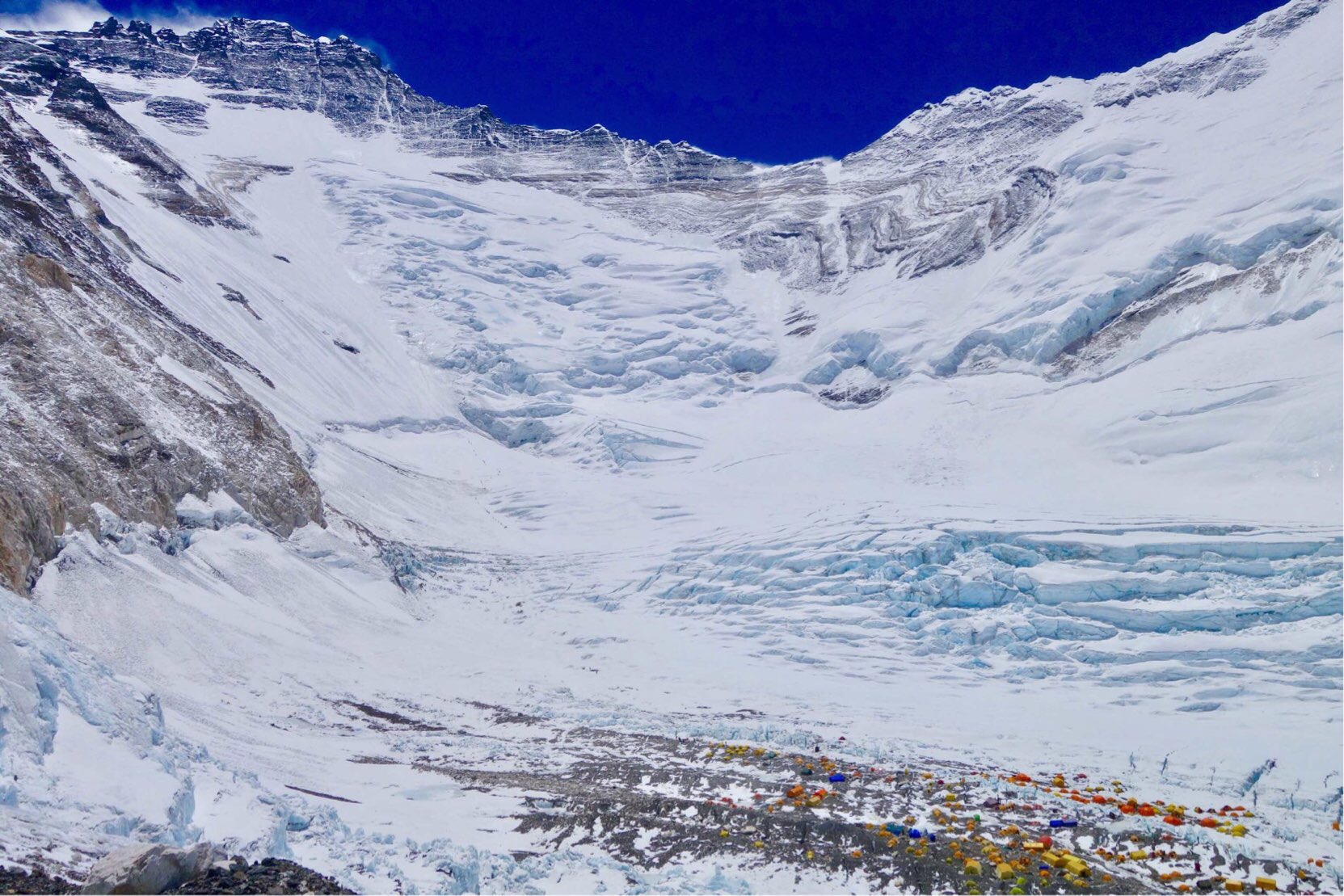
This remains a big “if” because it all depends on weather and how our bodies hold up but I felt obligated to share this with everyone to avoid confusion. I’m sure many of you already think I’m crazy but it would be worse if I waited to tell you until after summiting Everest. I liken it to one of those stressful suspense movies that you hope are over but then they just keep dragging on and on and on. I didn’t want to do that to everyone who has shown so much love and support towards me.
The bottom line is that in just over 12 hours, I depart to give Everest my all. If it is God’s will, we will be successful and then evaluate whether or not we are fit to attempt Lhotse. Please keep those prayers coming, they mean the world to my team!
PS – Mom, you have no idea how sorry I am to tell you this and cause you additional stress. My only justification is that I believe we can do it and don’t want to live with the regret of not trying. I promise to do everything in my power to climb safely. I love you.
-John
Fear
I wrote this a couple of weeks ago and had planned on sharing it with you before we began our Summit Rotation. Now that we have decided to break camp in about 30 hours, to make our push for the summit, I suppose it’s as good of a time as any. Also, this was written before Ueli Steck fell to his death and I feel that it is even more appropriate now than before…
On our trek into EBC, Brent and I began discussing the fear that each of us carry as mountaineers. He shared a quote from French climbing philosopher, Rene Duamal, who wrote: “The Himalayas of the mind are not so easily attained; there is more than storm and precipice between you and your Everest”.
We all have fears in life and I would guess that any two of us have at least half of them in common. Every day of my life, I have fears and many of them are probably the same as you… failure, self-doubt, embarrassment, death. In the mountains, I spend a lot of my time reflecting on my life and attempting to gain a better understanding of who I am. These fears that I mentioned are present every single day that I climb and while you may not sense it in me, they are there. Some days, I wake up fearful that my physical ability is not enough to succeed in this climb, probably more often than you can imagine, but I refuse to allow that fear get in the way of giving it my damnedest!
Why am I writing this? I want you to think about your fears and if they are stopping you from following your dreams. As I head up Mount Everest, there are a number of factors that I truly fear but I plan to face them head on. It’s ok to have fear but not if it gets in the way of the life that you want to live. Some of you may have heard this before but my favorite quote is from Helen Keller, “Life is either a daring adventure or nothing at all”. I’d be lying if I said that this mountain didn’t scare me but I’m not going to let that get in the way of my “daring adventure”.
Do what you love.
-John
Q&A
Stephanie:
- How is weather determined when finding an opening to make the final summit? Each team generally pays a meteorologist for forecast information. We receive weeklong forecasts that show current conditions and trends for the upcoming week. It may seem obvious but forecasts are based on the accuracy of the previous day. Each time that we have an accurate forecast, we gain more confidence in the trends of the long-term conditions.
- Knowing that making it to Base Camps above EBC can take days, what factors are considered when deciding a final summit is safe or clear? We won’t begin our summit rotation until we are very confident in the accuracy of the forecast. Once we feel confident, we will move to Camp 2 and then move up as weather permits. When at Camp 4 (high camp) the most important variable that we watch is wind, followed by visibility. Temperature isn’t a big factor because we have insulation to combat the cold, it is wind that can crush a team. We most likely wouldn’t move from C4 if winds are expected to be over 20 MPH or visibility is poor.
- Does weather not change as quickly as I’m thinking it does? It does but in the Himalayas it is more predictable than some other mountain ranges. I don’t claim to be a scientist so I won’t get into details but a Himalayan forecast is much more predictable than an Alaskan forecast. Additionally, forecasting technology for mountains is far more efficient than it used to be but it’s important to remember that you are rolling the dice anytime you go above 20,000 ft.
- Do your pee bags travel up the mountain with you when you climb or is that just a tent luxury? Pee bottles move from camp to camp. They come in a variety of shapes and sizes, based on preference of the climber, but I use a Nalgene Canteen 64 oz. The reason that we use pee bottles is because it takes too much time to get dressed to go outside in sub-zero temps. We have to sleep with them near us because they will freeze into a brick if we don’t. Once we wake up, we empty them out.
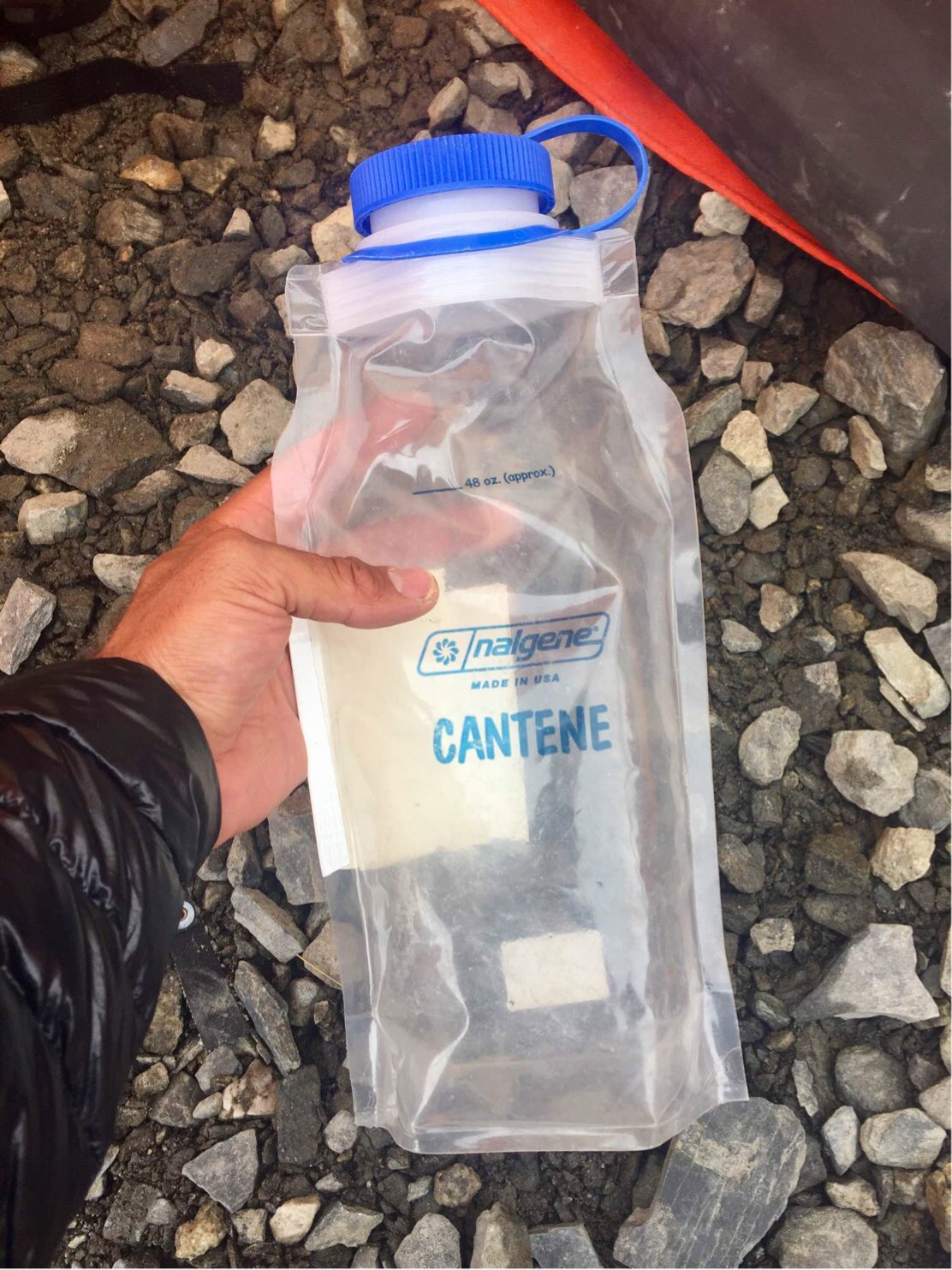
- And what about the “other” waste? Depends on the camp… at EBC and C2 we have mini-tents that have a bucket in them. Once the biodegradable bag in the bucket is filled, they are disposed of in deep crevasses. For C1, C3, C4 and anywhere else, we use wag-bags, basically a biodegradable and sealable bag that can be used a couple of times before it is disposed of in a deep crevasse. We carry these with us as we move, until we find a location to dispose of them.
Tante Lisa:
- Do you use just one pair of boots or do you have different boots for different terrains? I have two pairs of boots, one for the trek in and one for climbing. Climbing boots are unique because they have rigid soles, to provide more support and prevent crampons from popping off. It would be nice to have a couple different pairs on the mountain because temps vary significantly from EBC to the summit but it just isn’t feasible to carry multiple pairs up and down the mountain. We choose our boots based on the most extreme conditions that we will use them in. In the case of Everest, we use boots that are referred to as 8000 Meter or Triple boots (because of their construction). They have an inner boot, an insulated protective shell and a built in knee-high gaiter.
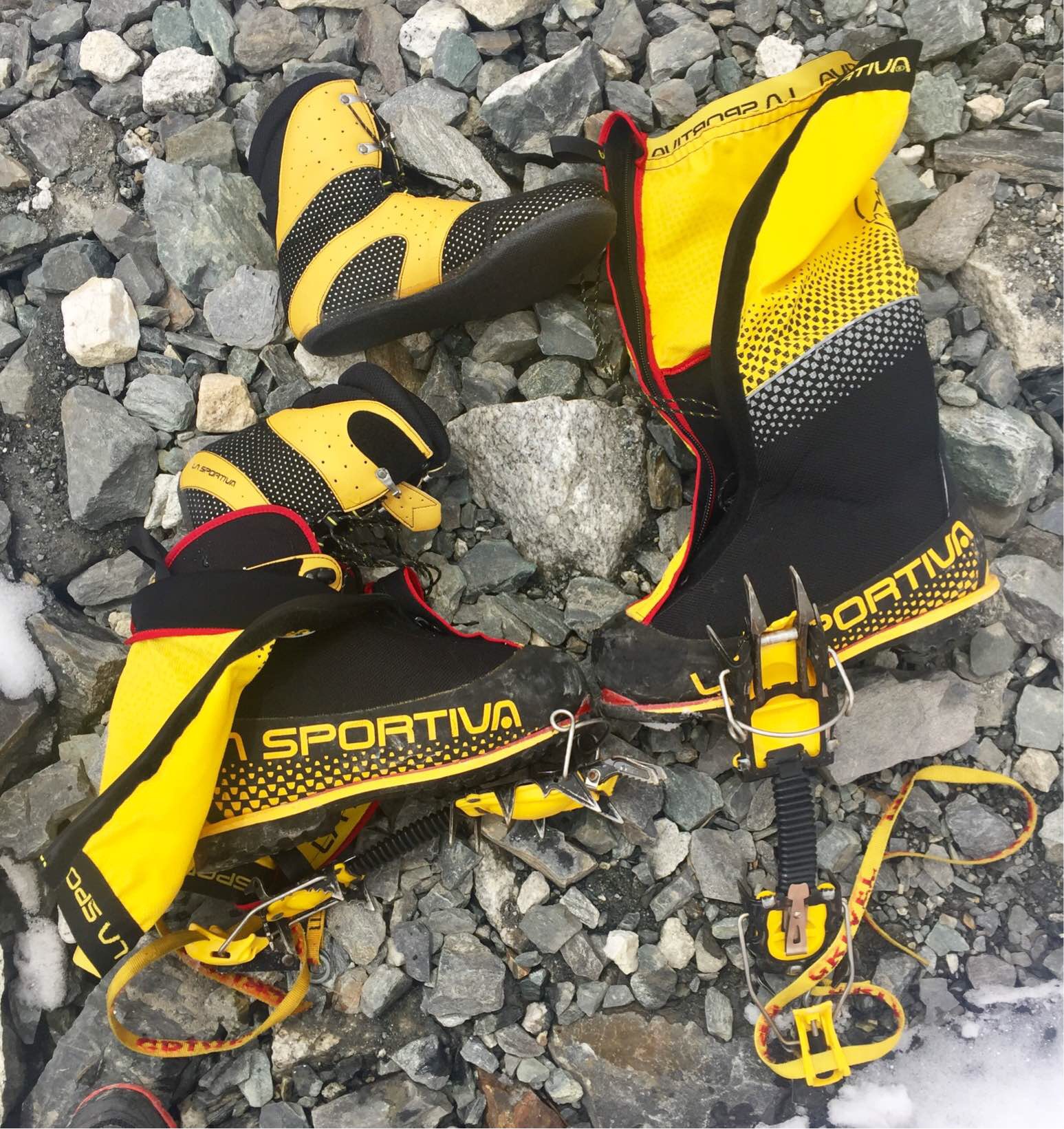
- Can you please take a picture of the inside of your tent(s) so we can see the luxury and will no longer feel so sorry for you? Photo and quick video tutorial provided.

- Have your finally recuperated? Are you still feeling poorly? Are you like other Stenderup men when you are sick? No, Yes, No. I went to the EBC medical tent a couple of days ago and they diagnosed my congestion as viral, so there is nothing that they can do about it. The problem is that my nasal passages are congested and I’m breathing almost entirely through my mouth. The cold and dry air at altitude does a ton of damage to the throat and since I’m only breathing through my mouth, it’s getting worse. I have to sleep and move with a buff on to prevent doing further damage at this point. Other than that, my body feels great so it will most likely just be a matter of suffering through it, it shouldn’t hinder my performance.
- Were you able to actually nap on those rocks? Of course I was! Being able to nap on cue is a very good trait in the mountains. Recreational napping and snacking are essential parts of mountain life. I can assure you that if you are a light sleeper, you are going to struggle to get rest in the mountains. I have learned that you can nap on literally anything if you have the right attitude, including rocks, snow, ice, and pee bottles.
Anonymous:
- Could you post some photos of some of the equipment you are using to climb? Here is a picture of my crampons (spikes that clamp onto my boots), as well as a picture of my harness and helmet. Make note of the silver device with the black handle at the bottom of the picture, it is my Ascender, which we use to latch onto the fixed lines at high altitude. Basically, it acts as a climbing ratchet. Unfortunately, a lot of my technical gear is already cached up high on the mountain, in preparation for my Summit Rotation.
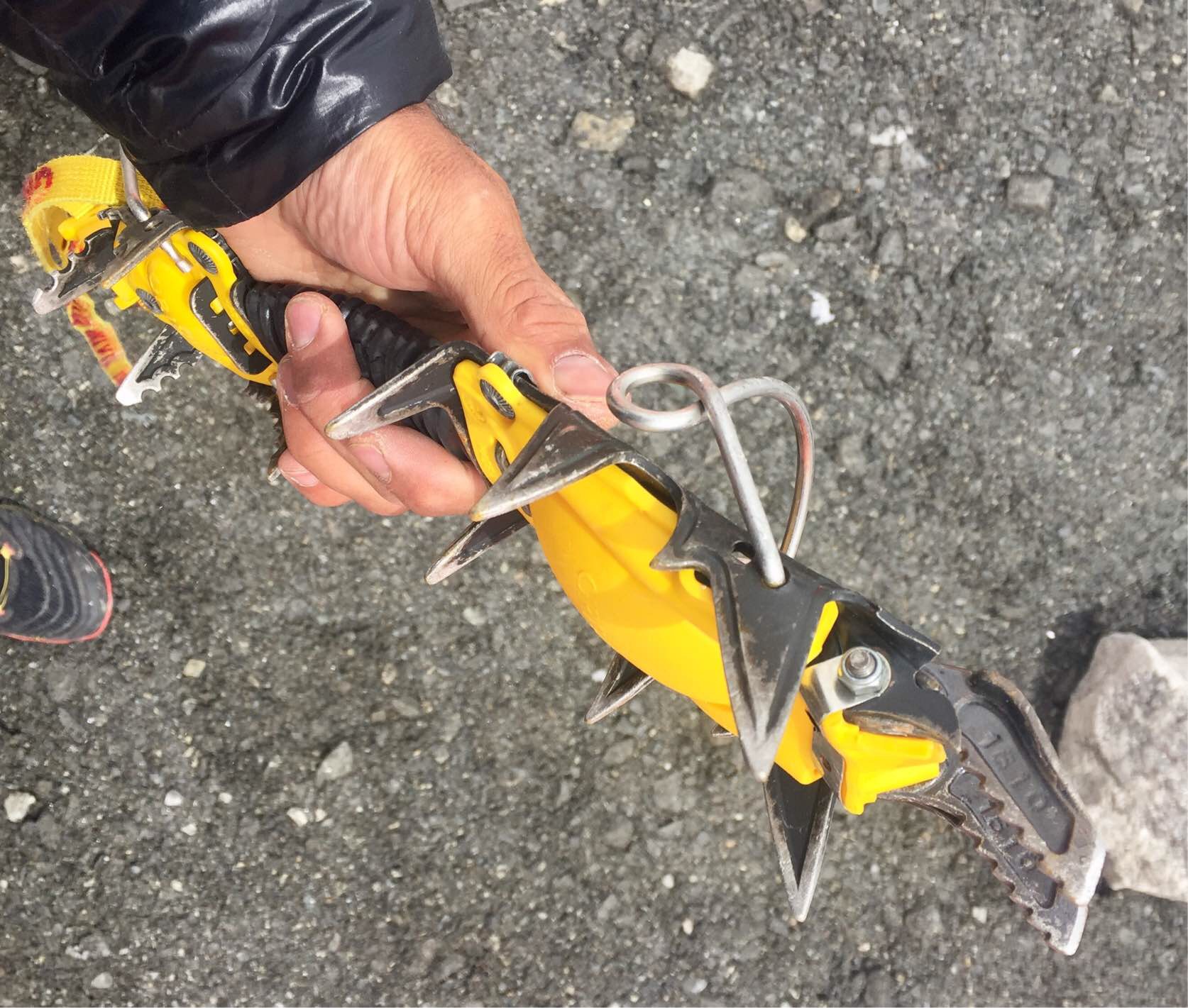
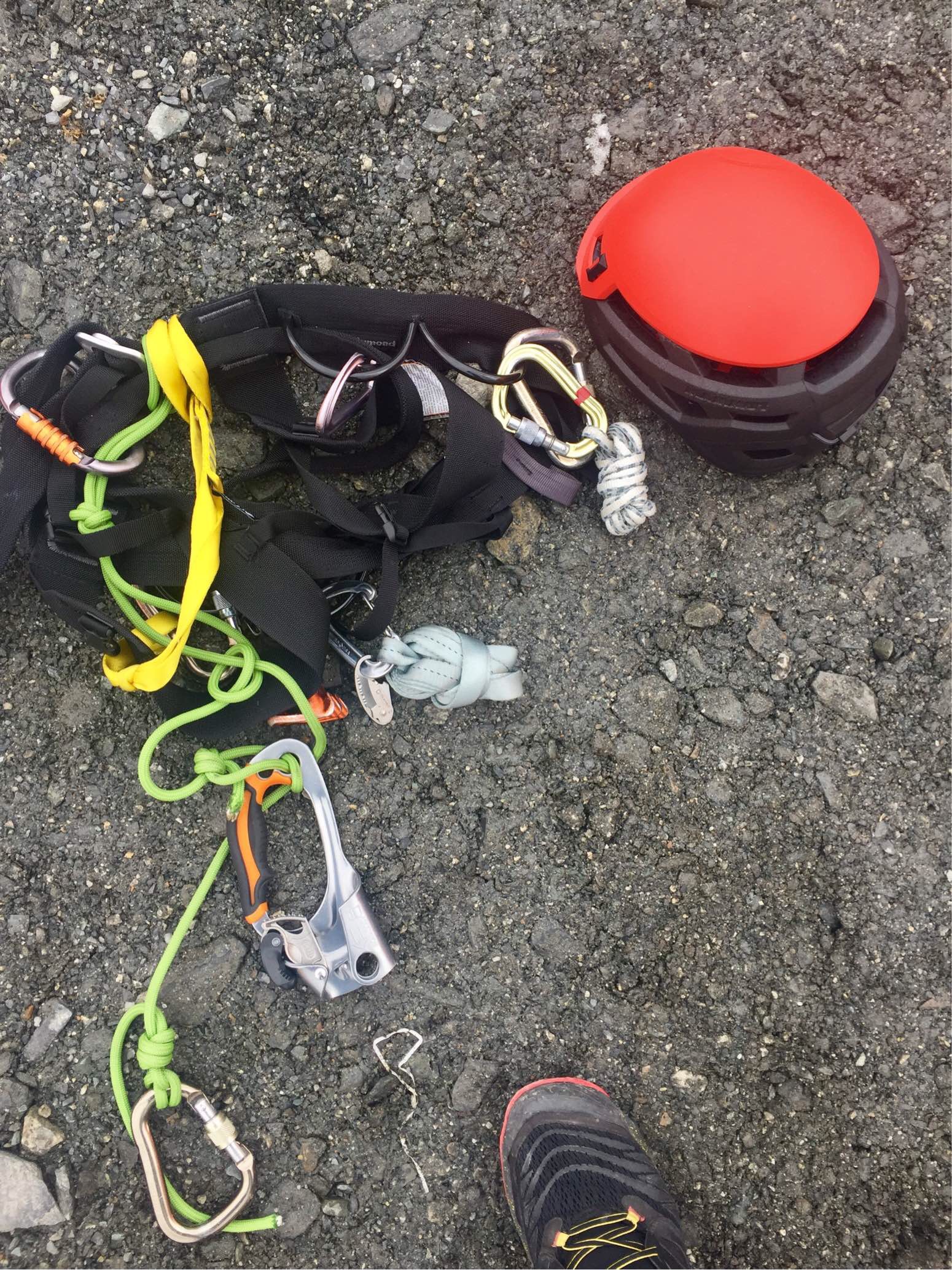
Brendan:
- How dare you? This is a rhetorical question.
- What’s your favorite flavor of jelly belly jelly bean? Peach
- How many of your fish do you think Rob has let die? Hopefully zero because I told him that he loses a finger for each fish death.
John:
- My question is all about Oxygen. How many cans of Oxygen will you need to get safely up and down? It depends. A very select group of people will climb without oxygen, but it’s usually only the most elite climbers, like Ueli Steck. We will use supplemental oxygen but it is up to personal preference as to how high of a flow rate that we will use. You can set O2 flow at 25%, 50%, 75% and 100% but this only means how quickly the O2 is flowing into the regulator, relative to it’s max flow. At max flow, a canister will only last 3-4 hours so you need to gage how long it will take you to climb before you determine flow rate. The faster you go, the more O’s you will need, but the less time you will need to be running the O2. We plan to move fast and will most likely consume about 2 canisters each on summit day.
- When do you start supplemental oxygen and who places the extra cans where they need to be and finally, how can we be sure that no one will mistake yours for theirs? On our Summit Rotation, we will actually start using O’s when we leave C2, in order to limit stress on the body. We already climbed to C3 without O’s, so we know our bodies can go higher without it but it allows for better performance later on if we are supplementing early. Sherpas carry and store O2 canisters in our tents at C2, C3, and C4. We have our own tents and camps, so there is no confusion.
Becky:
- Are you putting a CHR flag on the top of Everest? If I make it to the top, the CHR flag will be there! I also plan on having a Cal Poly flag to represent my alma mater.
Anonymous:
- You must be so glad to have that beard to keep your face warm. Are others jealous? Of course.
- Do people actually shave up there to stay clean shaven? I’m fairly certain that we refer to people without beards as “women”, correct? Just kidding! Some people do bring trimmers to shave at EBC but I think that it is a waste of time and weight. Personally, I enjoy having a beard because it protects my face from the elements. However, I am considering shaving it to get a better seal on my oxygen mask.
Anonymous:
- Why don’t you just Ski down? Would save you time and energy. Seems pretty obvious to me. Because I’m a bad enough skier that the descent would be more dangerous than the ascent. In all seriousness though, the summit ridge has huge drops and is primarily windswept ice, that is not conducive to skiing. However, some people have successfully skied off of portions of Everest.
A Sad Day on the Lhotse Face
Geoff has experienced more loss in the mountains than I have, which is why it was important to me that he share his perspective. Below, I have included my journal entry from the date of our climb to Camp 3 and Ueli’s death. Before you get to reading my post, I will be updating everyone on our plan for our Summit Rotation, tomorrow.
-John
Sunday, April 30th
I was first drawn to mountaineering and climbing because I was amazed by how the human body’s ability to persevere and accomplish what some deemed as impossible. Over the years, I’ve also witnessed the opposite end of the spectrum, the human body’s frailty when facing Mother Nature. These two thoughts seem counterintuitive to one another but in actuality, they exist together in the mountains. The human body is capable of far more than most of us give it credit for, it is an amazing creation that can accomplish the near-impossible when we apply it properly. However, this amazing creation is easily snuffed out by the incredible force of Mother Nature. These two seemingly counterintuitive thoughts and the spectrum that they run along, is the reality that mountaineers face.
During our breakfast, we heard a helicopter overhead and we each gave one another a nervous look. It is not normal for helicopters to be spending time in Camp 2 and the only reason that they would be in the area would be for an emergency. Personally, I wrote it off as someone that had come down with a case of HAPE or HACE and needed to be evacuated. While this sounds horrible, it is much better than the alternative and I considered it to be an optimistic assumption. I quickly brushed it off and got to packing for the day because we had a big day of climbing up to Camp 3 (23,400 ft).
The grind up the Western Cwm to the Lhotse face was not enjoyable because my sinus infection had worsened. I kept a slower than normal pace, as to not do any more damage to my throat. I was grinding it out and we had almost reached the Bergshrund (the large crevasse that often separates the lower glacier from the face of the mountain), when Brent yelled from behind “Boys, hold up… I have some bad news. Actually it is REALLY bad news.”. I stopped immediately, turned to him and saw by the look on his face that he was serious. I will never forget the moment that he said, “Ueli is dead”.
Ueli Steck was the best alpinist in the world, when he died this morning on the North Face of Nuptse. He has made some of the most incredible ascents in recent memory, which have inspired me and many others to follow our dreams. Around 9 AM this morning, he was doing a preparatory climb on Nuptse, one of the mountains that he was planning to climb at a rapid ascent rate without oxygen, when a serac broke above him and killed him. It had been common to say “Hi” to Ueli as he walked through camp and watch him as he did training climbs throughout the Khumbu Glacier. I can’t believe that just 15 days ago, he was having lunch with us in our dining tent while we prodded him for information on his objectives while in the Khumbu. Despite the prodding, he was very humble about it and far more comfortable talking about life and laughing. It’s still difficult for me to comprehend that the helicopter we heard was the one called to recover his body.
Brent, Anders, Geoff and I stood there, just below the bergshrund and we let the news soak in. We were all in shock. Despite his humble demeanor, Ueli was someone who bordered on superhero status in the climbing community and his string of amazing accomplishments only made his demise seem less likely. The fact that it occurred less than a mile from where we were eating breakfast, made it even more surreal. We eventually regained enough composure to push on to our objective, Camp 3, but no one was quite the same for the remainder of the day.
Geoff, doing his best to keep us motivated during our climb up the Lhotse Face. 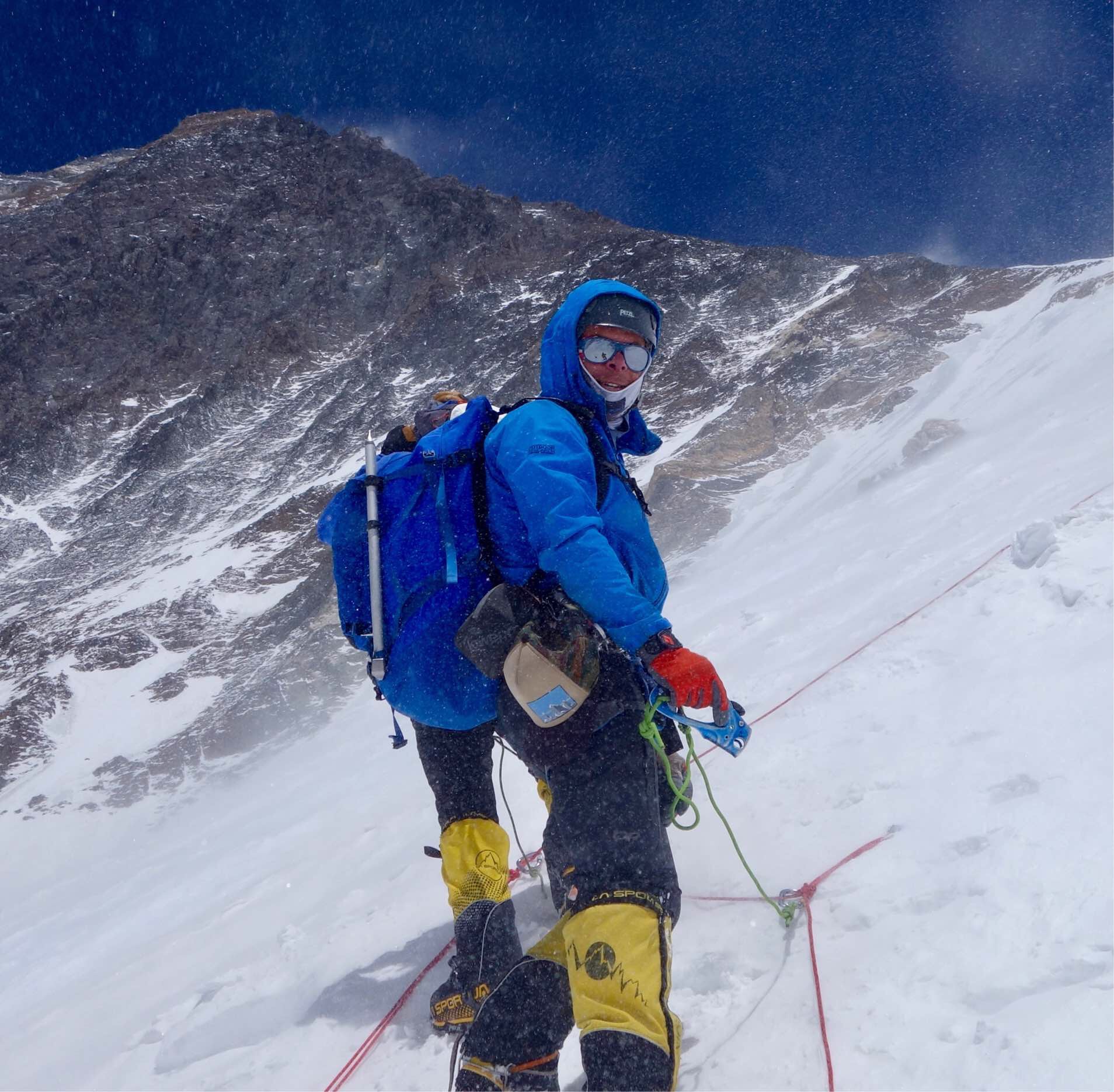
While my legs felt strong and we made the climb from Camp 2 to Camp 3 in just under 3 hours and 15 minutes, I couldn’t shake the thought of Ueli. I found myself thinking of my Mom and what she would think when she heard the news. I found myself thinking of the inherent dangers that I face whenever I step into the mountains and my own mortality. I also found myself thinking of my fears, which are always present. Many of you probably think that I am crazy because of what I do but I can assure you that I am well aware of the danger and constantly feel fear. I know that Ueli did too.
Anders and I, relaxing for a quick minute at Camp 3. 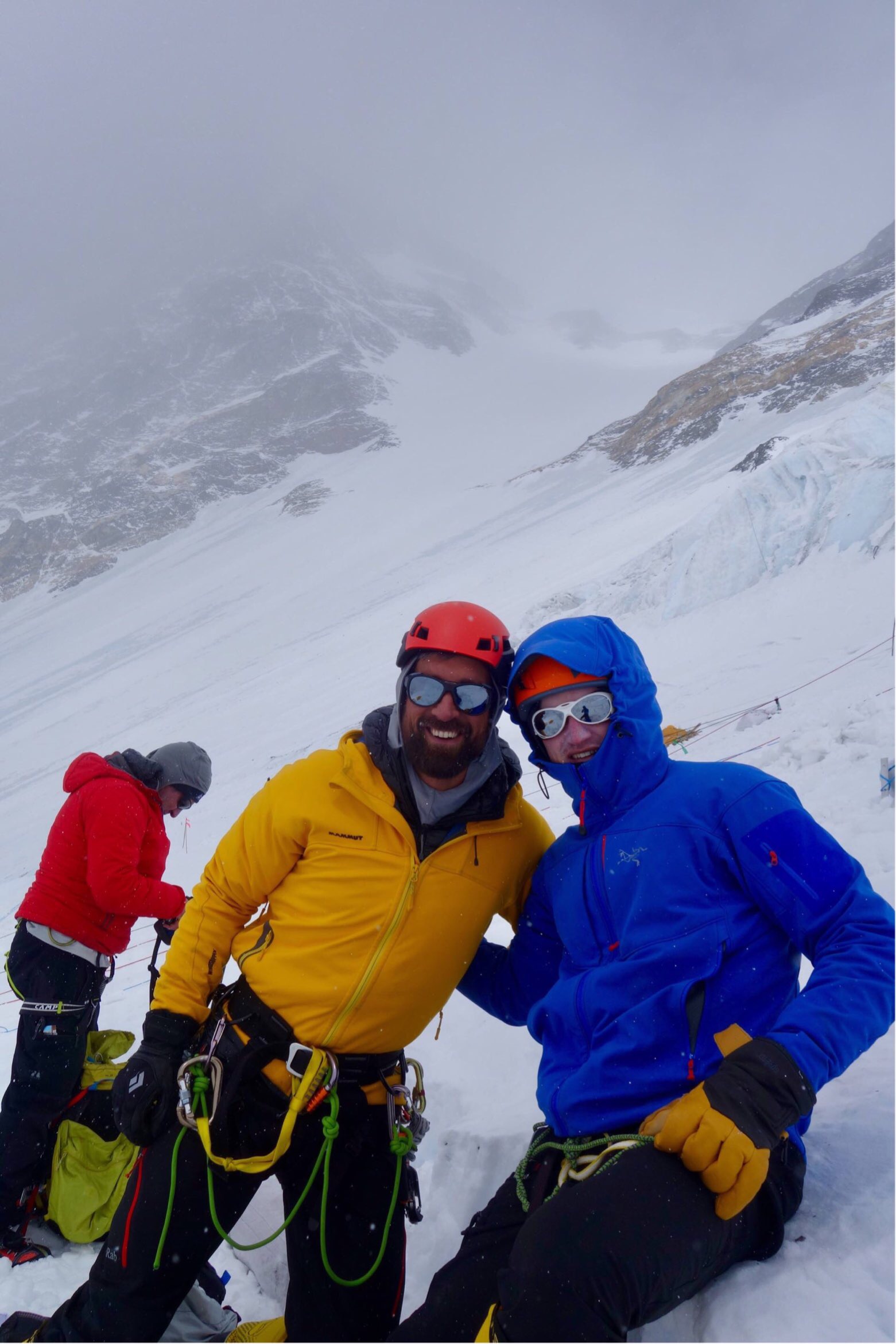
There were a lot of hugs and high fives today, definitely more than usual. Our little team is strong and not just from a physical standpoint, we know that we can rely on one another. If we find success on this mountain, it won’t be because of the strength of our legs but rather, the camaraderie that we have developed.
We made short work of the ascent to Camp 3 and the descent, despite the tragic news and me being under the weather. We knew that we had work to do and that not finishing it would put us in more danger for our Summit Rotation. Not completing our climb to Camp 3 was not an option. We rallied around one another and got it done.
My team, descending to Camp 2 after a tough but successful climb to Camp 3.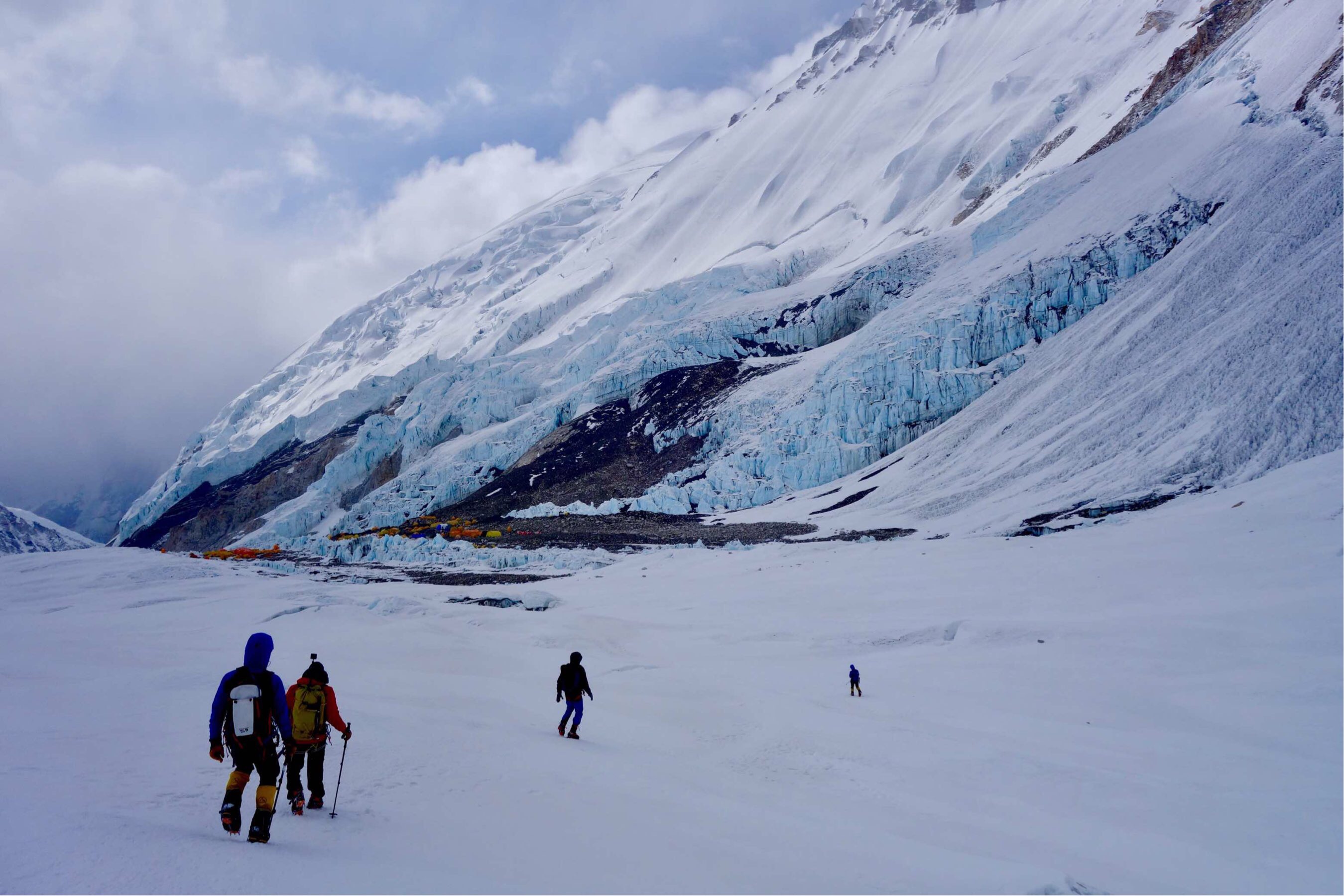
Ueli Steck has completed some of the most challenging climbs of all time and he lost his life, doing what he loved while on Nuptse on April 30th, 2017. Brent’s Father, Barry Bishop, was a member of the 1st American team to summit Mount Everest in 1963 and the 1st person to ever summit Ama Dablam. He was killed in a car accident in 1994. My point here is that you never know how your life will end, so you better make the most of it. Face your fears and follow your dreams, otherwise what is the point of living? I know that I face danger every single day in the mountains, but the experiences and relationships that I have found are worth the risk, tenfold.

